Before my first trip to Germany, a friend told me to visit Dachau Concentration Camp and that the experience would change my life. Wait just a minute… can you visit Dachau? Yes, you most certainly can.
The former concentration camp has since been turned into a memorial site. It opened to the public in 1965 and welcomes around 800,000 visitors each year.
And while visiting a concentration camp was completely off my tourist radar at the time, I took him up on his suggestion. My first time visiting Dachau Concentration Camp was back in 2012 and my friend’s prediction proved true. The experience changed me. I’ve since been back in 2019 and 2024 (and will visit again in 2025), and it changes me more every time.

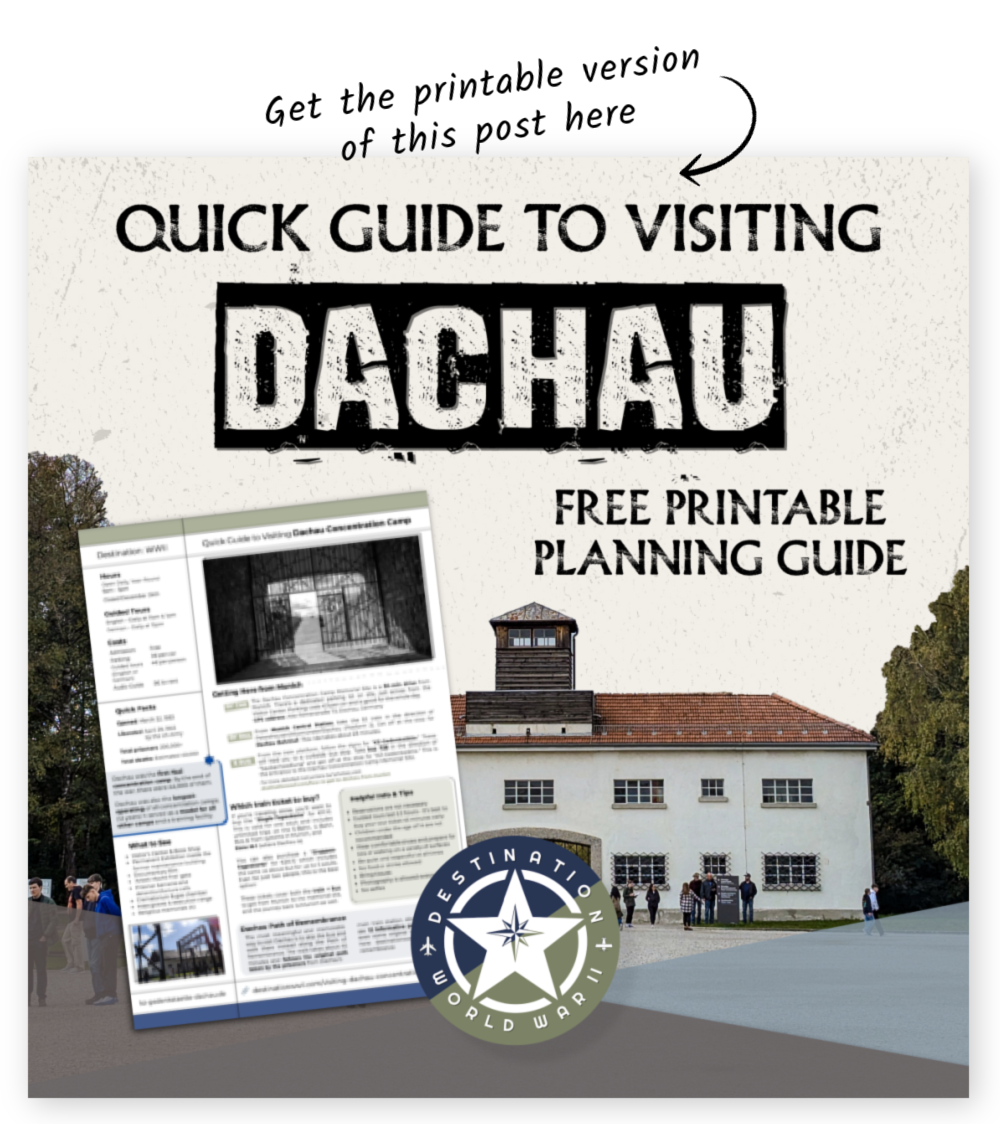
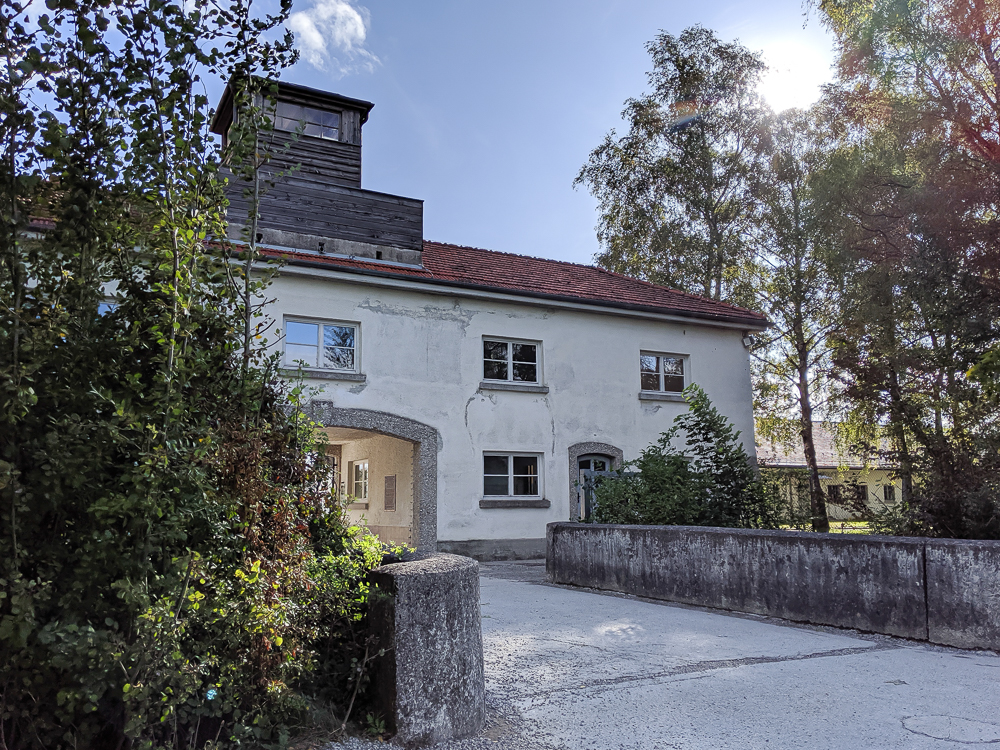
Is it worth visiting Dachau Concentration Camp?
Absolutely, 100%, it’s worth visiting Dachau Concentration Camp. You can’t understand suffering, fear, perseverance, and you really can’t understand the Holocaust until you’ve visited a concentration camp.
The experience is unlike even your wildest imagination and it’s so much bigger than you’ve ever imagined. It’s not necessarily a pleasant way to spend a day on vacation, but it’s definitely a worthwhile and important one. If you’re looking for a no-holds-barred WWII learning experience, this is about as raw as you can get.
Because seven years had passed, I spent some time visiting Dachau Concentration Camp again in September 2019 to refresh my memory. It turns out I’d remembered everything from my first visit, word for word, image for image. At the same time, I’ve since visited even more times, and still I learn something new each time.
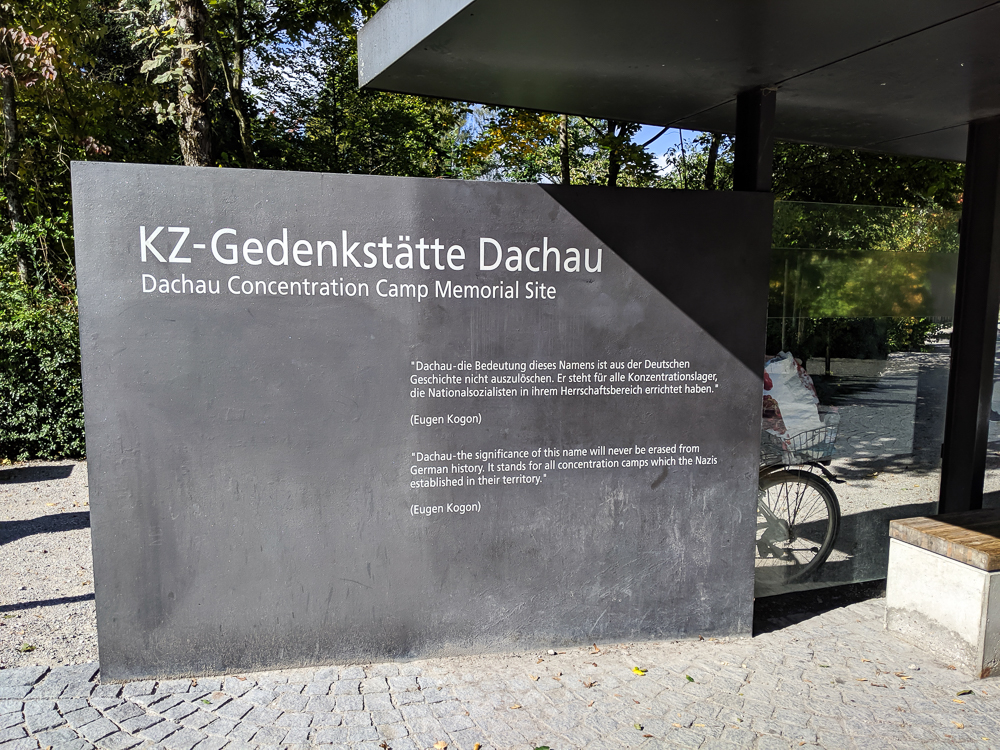
You can find my full guide the World War II sites of Munich in this link.
About Dachau Concentration Camp: some facts
1. Dachau Concentration Camp began operation on March 22, 1933 in the town of Dachau, about 10 miles northwest of Munich, Germany (the birthplace of the Nazi party).
2. It began as a camp strictly for political prisoners—social democrats, communists, other Nazi political opponents and the like—and held 4,800 prisoners when it opened.
3. As we know, Dachau expanded in both size and population to imprisoning other groups like Roma, homosexuals, Jehovah’s Witnesses, and in the days following the Kristallnacht of November 9-10, 1938, 10,000 Jewish men. Historians estimate that during its existence, 41,500 people died at Dachau Concentration Camp. However, we will never know the exact number.

4. Dachau Concentration Camp was the first ever Nazi concentration camp in what would become a total of 44,000 camps and similar incarceration centers.
5. Nazi authorities used it as a training facility for SS camp guards. Because of its “success,” it served as a model for all concentration camps built afterwards. American troops liberated the camp on April 29th, 1945. It was the only concentration camp in operation for the entirety of the Third Reich.
Looking for another great day trip from Munich? Don’t miss the Eagle’s Nest in Berchtesgaden. (And the many other WWII sites in Berchtesgaden.)

How to get to Dachau Concentration Camp
Located just 10 miles from Munich, visiting Dachau Concentration Camp is both quick and easy via public transportation or by car. I’m going to briefly summarize how to get here from Munich below, but definitely check out my comprehensive guide on how to get to Dachau from Munich.
That link has everything you need–all 5 ways to get here with all steps included. Which trains to take, which train tickets to buy, where to find the trains and buses, and tons of pro tips (because I’ve personally visited 4 out of the 5 ways!).
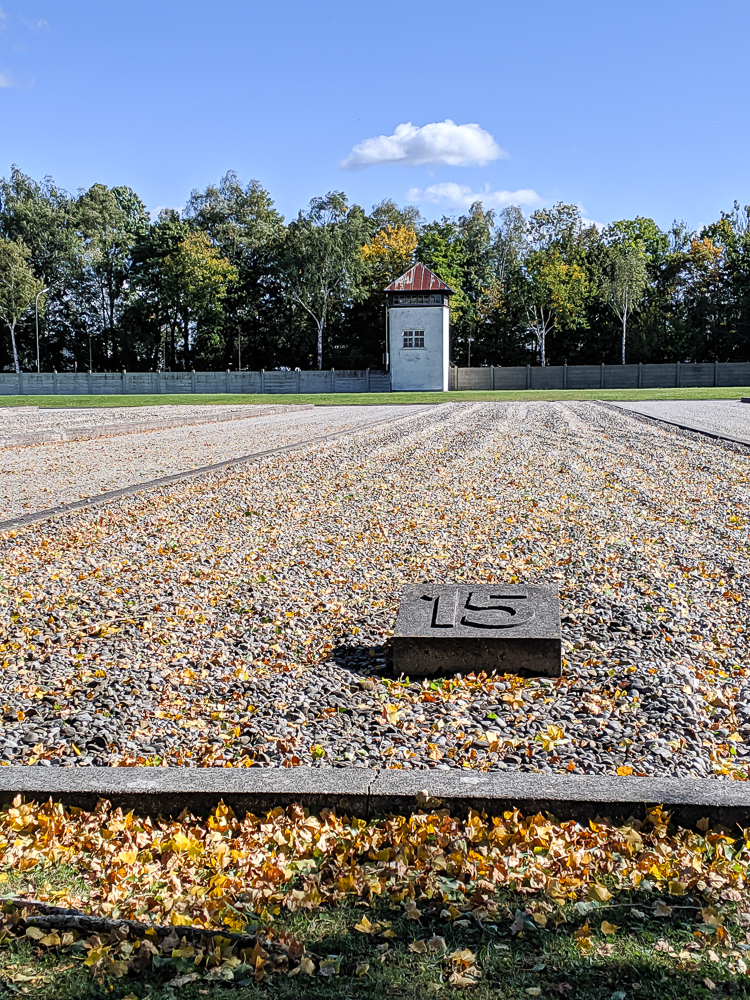
Visiting Dachau Concentration Camp by car
To drive to the Dachau Concentration Camp Memorial Site will take you just about half an hour. It’s a quick and easy drive, and there’s a dedicated parking lot once you get here. Parking costs just €3 per car. Take a look at rental options here if you’d prefer to drive.

Visiting Dachau Concentration Camp via public transportation
The most common way to get here is to take the train from Munich, and then the bus from the Dachau train station to the memorial site. Set aside about an hour each way for this, though it will most likely take much less. (It’s always good to be prepared for delays and such!)
You can take either the S2 train or the RB16 train from Munich Hauptbahnhof. The S2 will take you about 25 minutes to get from Munich to Dachau and trains leave every 10-20 minutes. The RB16 is a direct train that takes about 11 minutes and these leave once per hour. (You can see train timetables here.)
Once at the Dachau train station, you’ll then take Bus 726 from here to the former concentration camp. This ride takes about 10 minutes and drops you off right behind the Visitors Center.
For more on which tickets to buy and exactly which trains to get on, see my guide to how to get from Munich to Dachau here.

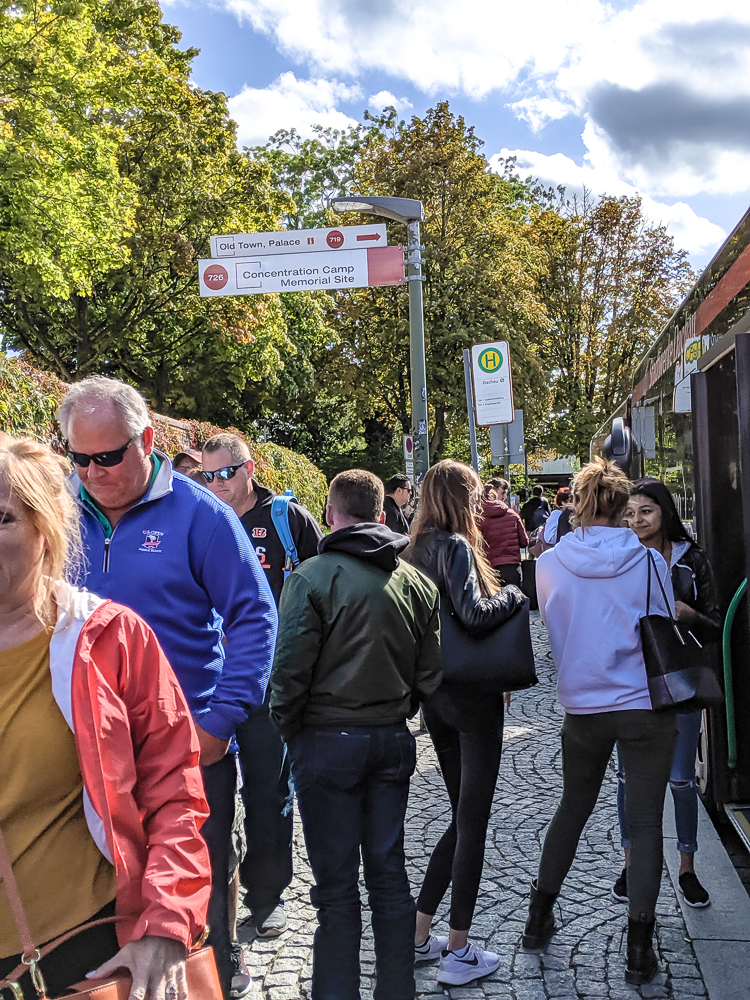
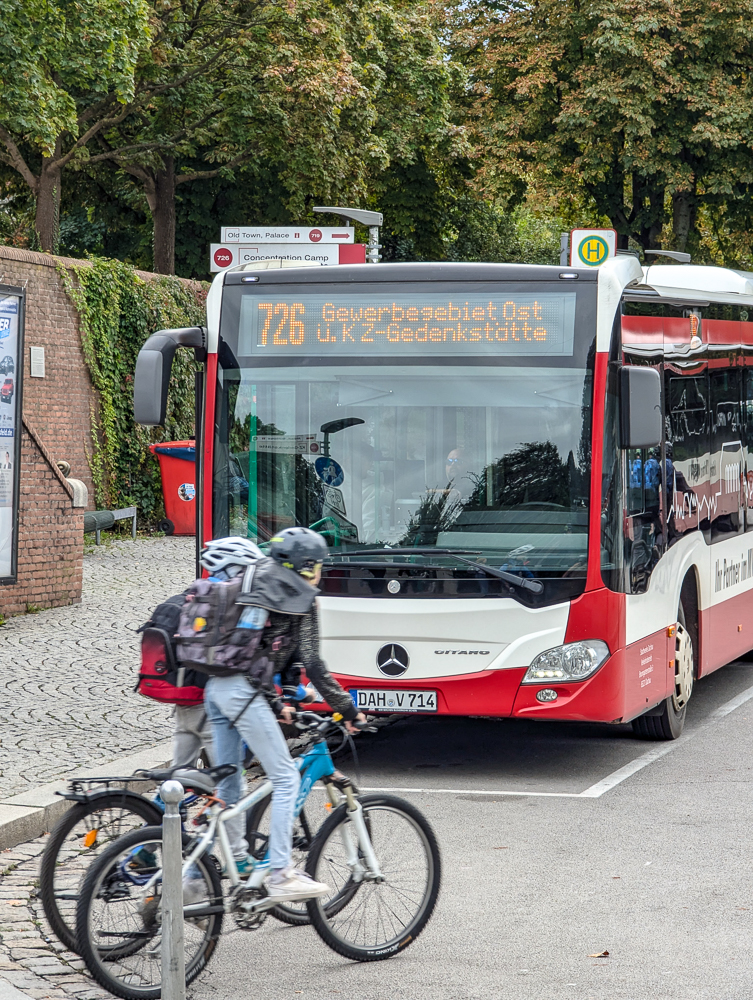
Walking to Dachau Concentration Camp
Instead of taking the bus from the Dachau train station to the former concentration camp, you can actually walk if you want. In fact, I encourage you to do so!
The route from the train station to the memorial site is an official walking route called the Path of Remembrance. It follows the original route the prisoners were forced to take after arriving in Dachau. Along the way, you’ll get to read several informational panels on the camp’s history, the prisoners’ experiences, and more.
For all the information you need on arriving to Dachau this unique way, see my guide to walking the Dachau Path of Remembrance here.
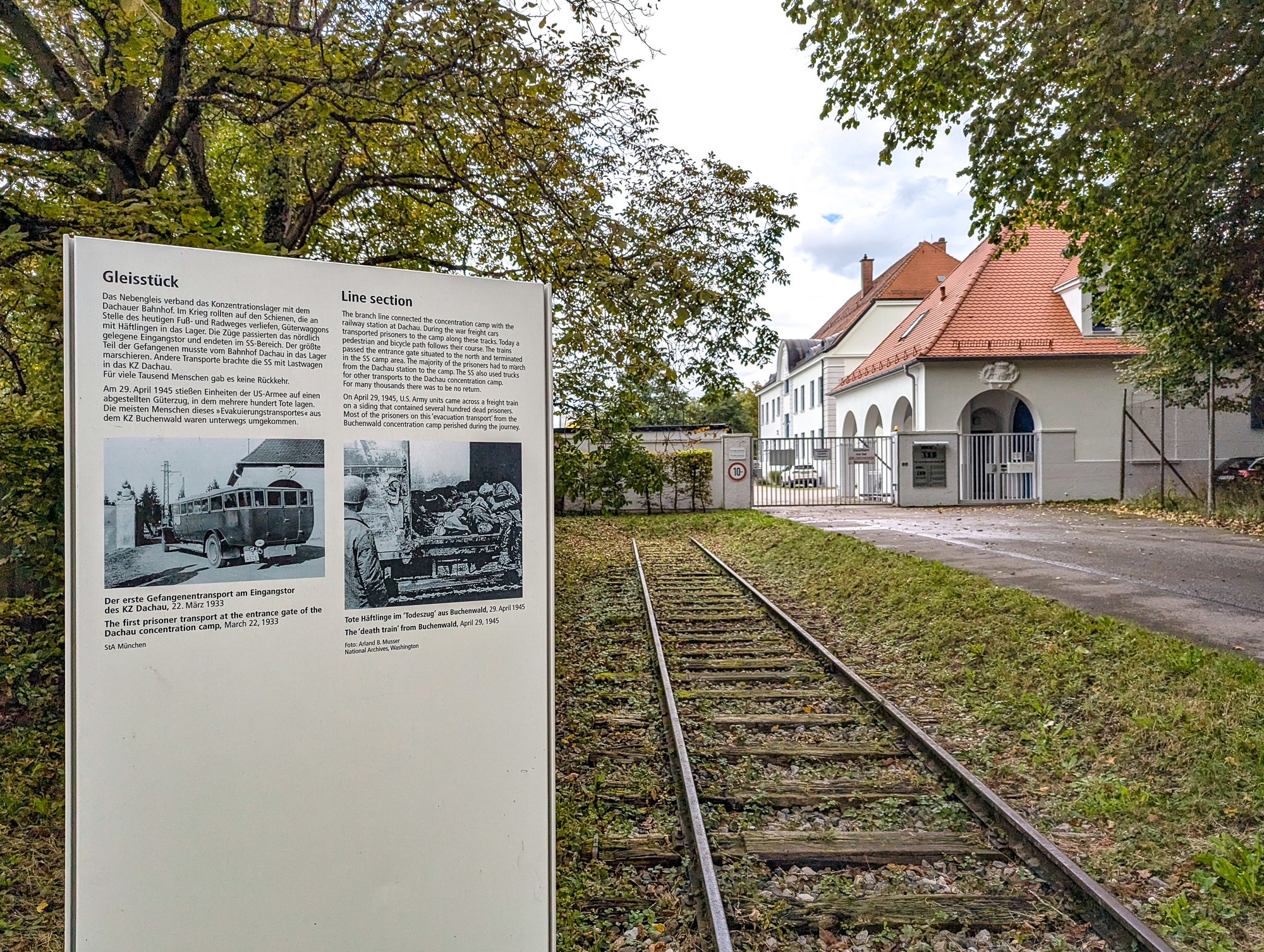

What to see when visiting Dachau Concentration Camp
Technically speaking, when visiting Dachau Concentration Camp you can expect a large number of explorable sites spread out around an unbelievably huge piece of property. Among them you can see:
Visitors Center
This is where you’ll want to begin your visit. (And will be the first building you encounter upon arrival.) The Dachau Visitors Center includes:
- Cafeteria with snacks, drinks, hot meals, and plenty of indoor and outdoor seating
- Information counter where you can pick up audio guides and free brochures
- Tour group sign up and meeting spot
- Book store and “gift shop” if you want to call it that
- Restrooms
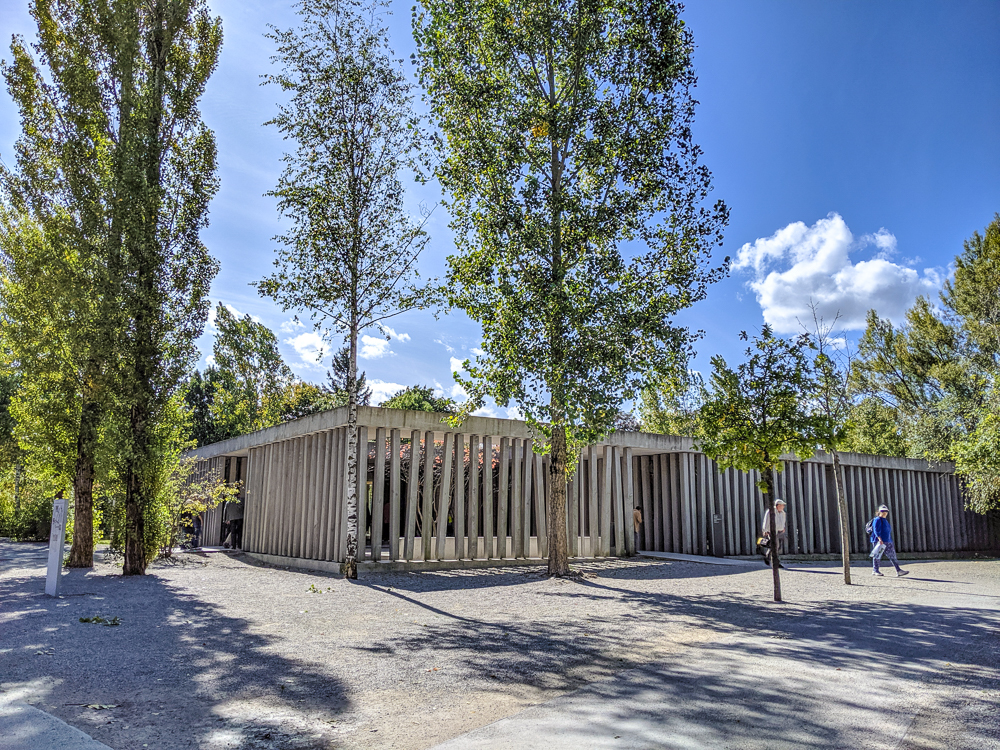
Read also: Visiting Terezín Concentration Camp from Prague: How to Get There, What To See, Tips, and More. (This is the camp commonly known as Theresienstadt.)

Many original buildings and historical sites
The former concentration camp served many different purposes after the war, so the camp has undergone many changes. However, some of the original historical sites you can see at Dachau include:
- The camp’s main entrance gate – the Jourhaus – which includes the famous “Arbeit Macht Frei” gate
- Several original guard watchtowers and barbed wire fences that surround the camp
- Original prison barracks and detention cells used to isolate, torture, and murder some of the more “troublesome” prisoners. (Among them, Georg Elser, the German carpenter who attempted to assassinate Hitler in 1939.)
- The camp’s original crematorium – This building also includes access to the fumigation cubicles and the gas chamber that was disguised as a shower.
- Mass graves, an execution range, and blood ditch – Follow the trail that leads into the trees behind the crematorium to see these.
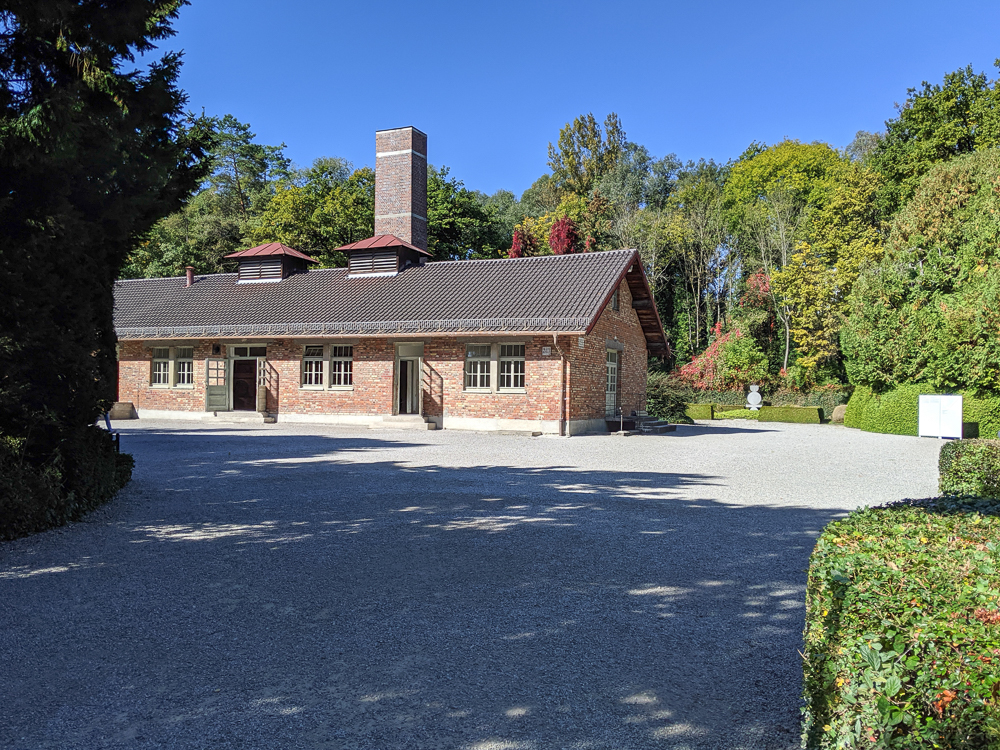

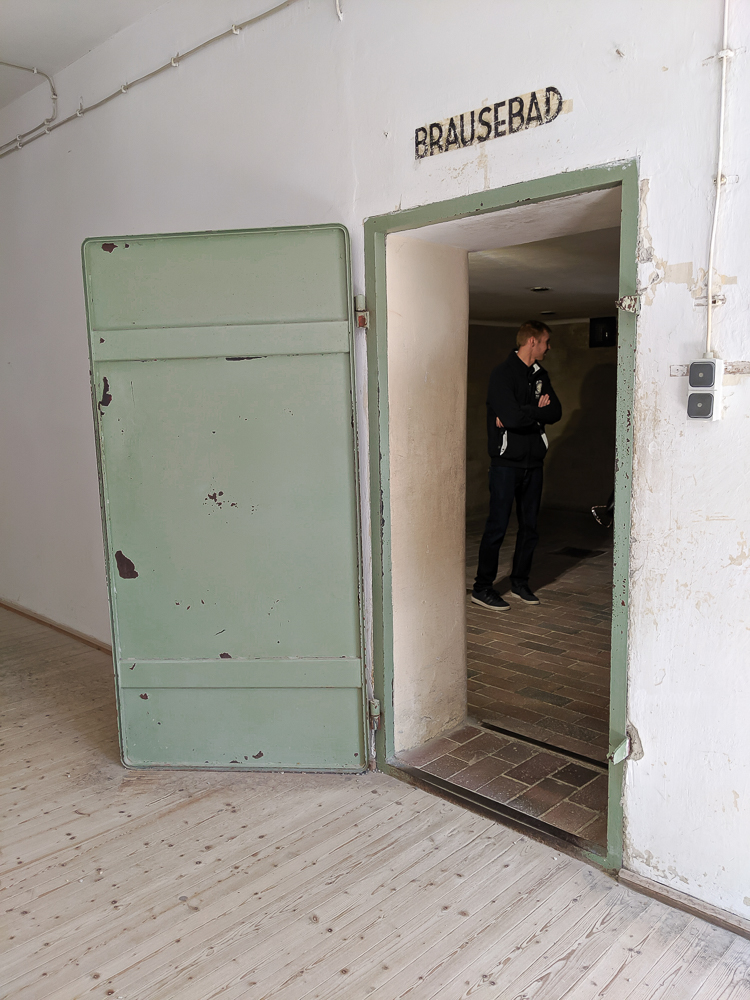
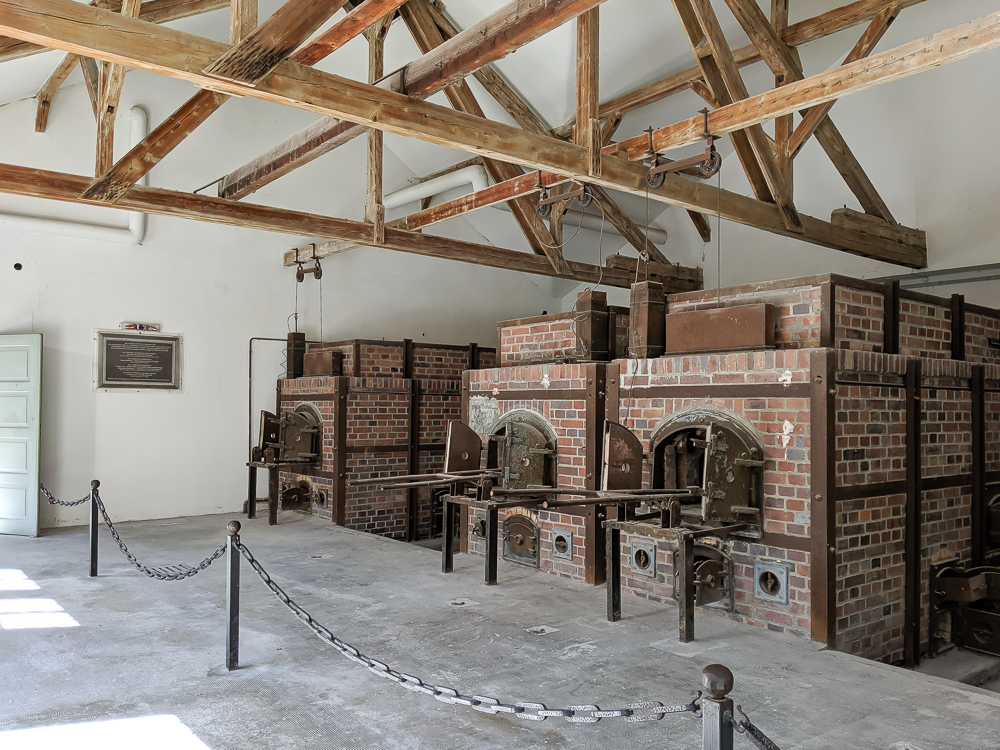
The Permanent Exhibition
The Dachau Memorial Site’s Permanent Exhibition is a large museum-type exhibition inside the former maintenance building. It consists of six sections spread throughout 13 rooms. Informational panels are in both English and German.
It focuses on several topics including:
- The prisoners’ arrivals at Dachau, their lives inside the camp, and their journey to either freedom or death
- Design of the camp and some of its key elements
- The events that led to a Nazi dictatorship and the development of the camp
- The evolution of the Nazi concentration camp system, including its final years
- What happened at the camp after the war
This exhibition is considered the bread and butter of visiting Dachau Concentration Camp and should not be missed. This part will take about an hour in itself. (It spans the entire length of the building.)
The permanent exhibition also features temporary exhibits as well. When I visited in October 2024 the featured exhibit was on the postwar Dachau Trials.
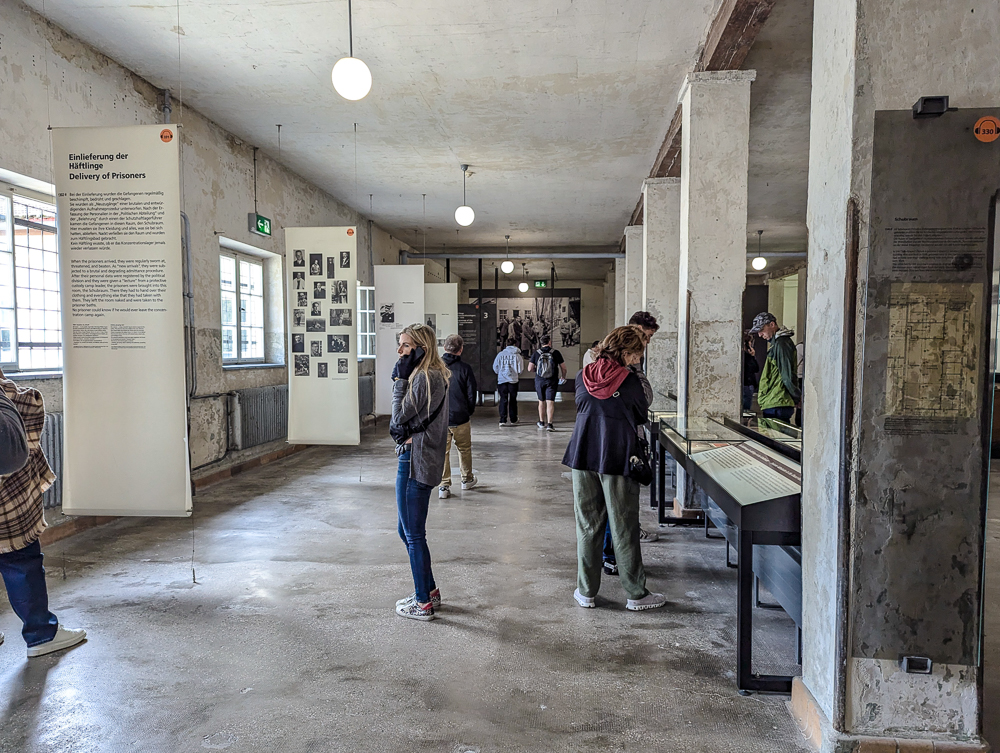

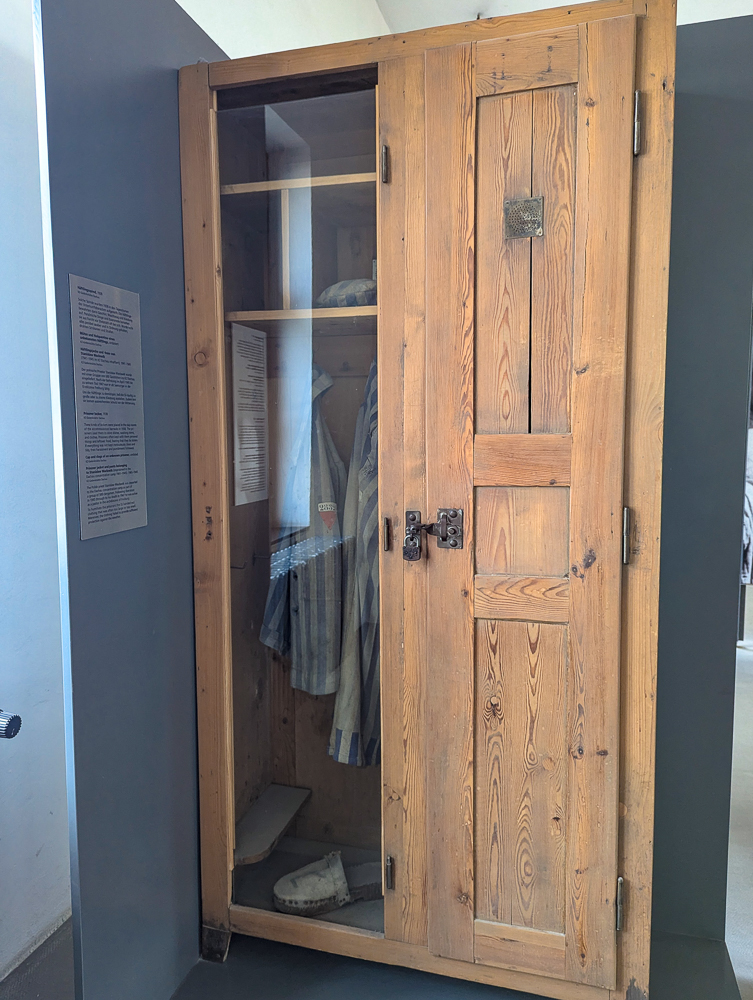
While in Munich, be sure to check out some of the many museums and memorials dedicated to the White Rose resistance movement.
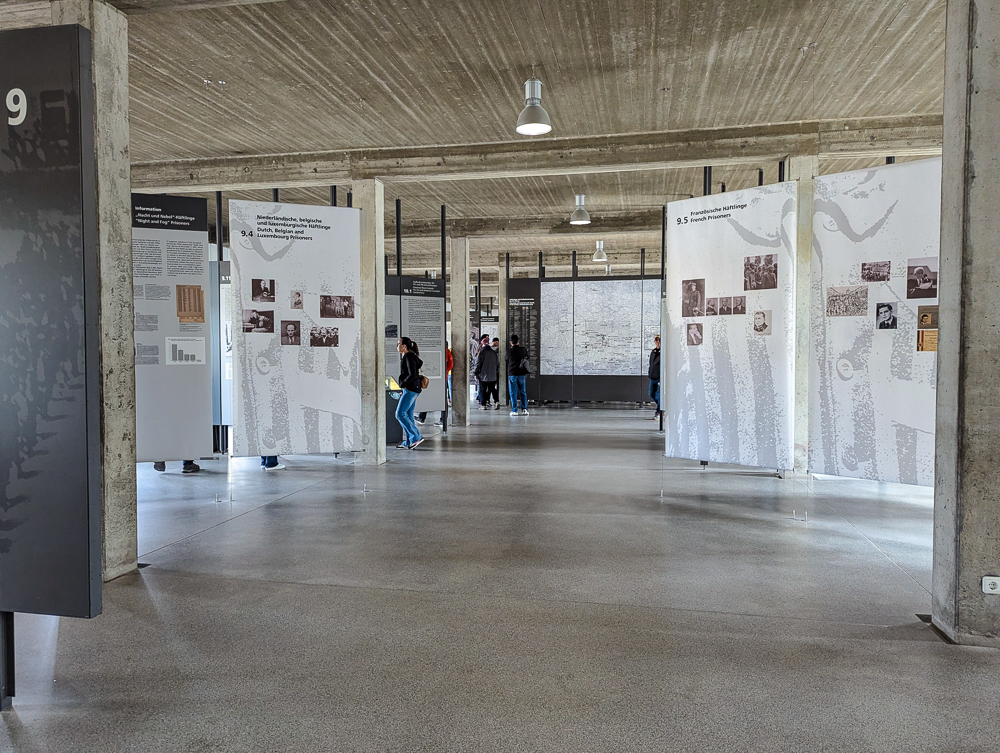
Documentary film
Within the permanent exhibition you’ll have the option of viewing the short documentary film “The Dachau Concentration Camp.” (New version as of 2021.) It covers the history of the camp as well as its implications today. I highly recommend it, but consider yourself warned. Bring tissues; not toddlers.
There are several showtimes throughout the day and in several languages. (English showings are at 10:15am, 11:45am, and 2:00pm.) More information here.
Recreated prisoner barracks
The original prisoner barracks were destroyed after the war, but they’ve since rebuilt one to original specifications. You’re free to go inside and check it out to try to get a feel for the prisoners’ living space.
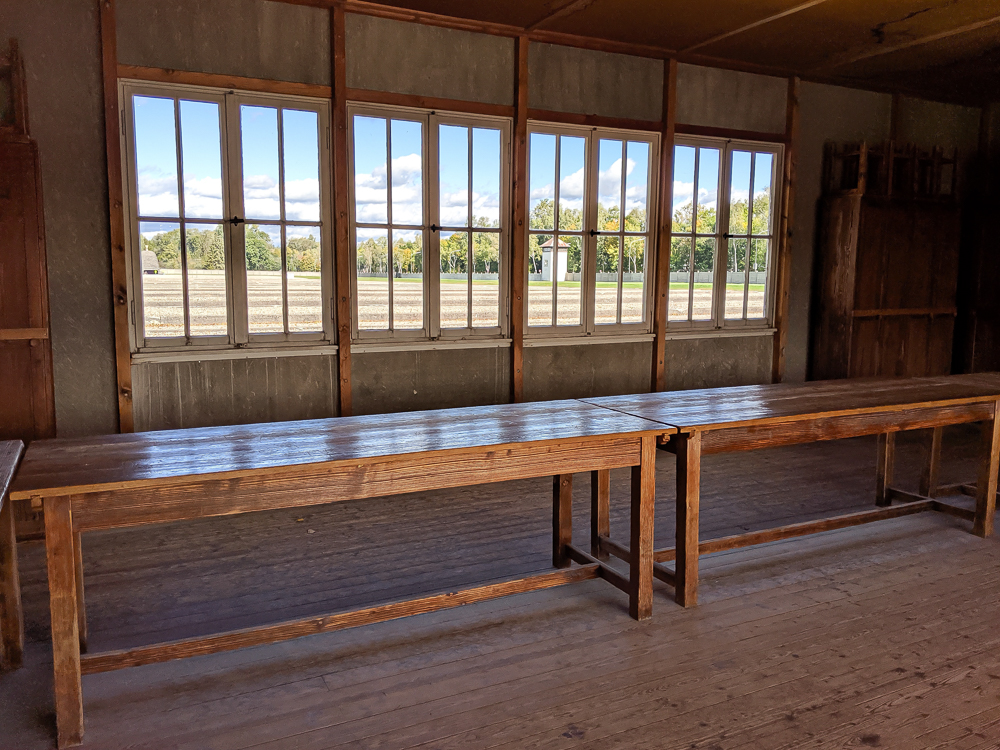
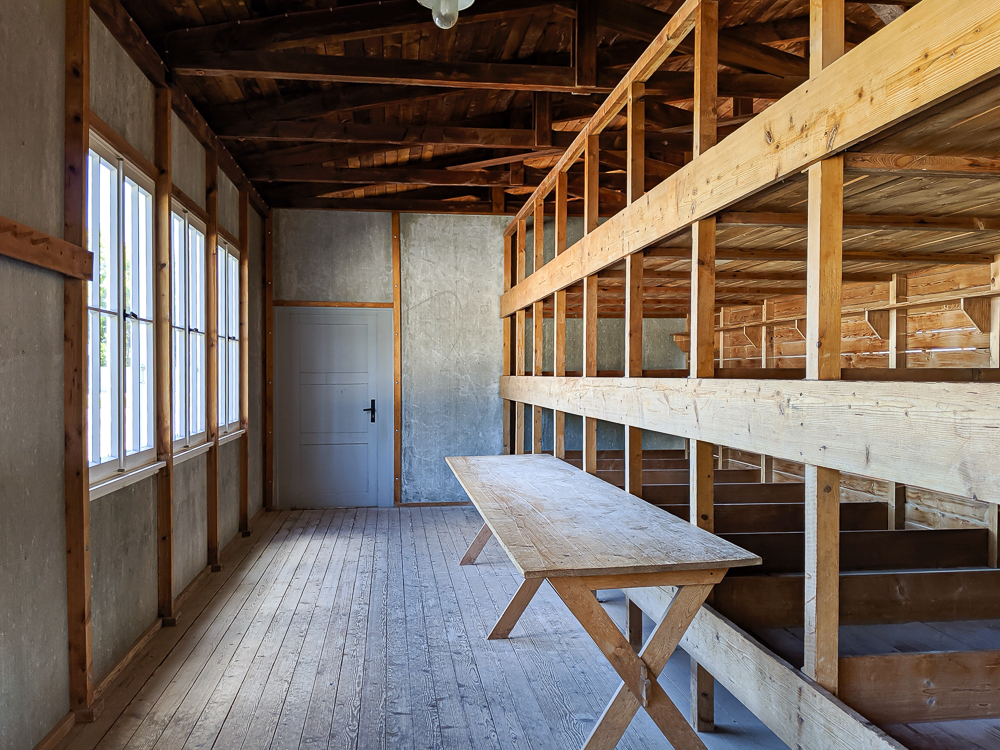
Camp Road & Roll Call area
The large gravel area outside the front of the maintenance building served as the Roll Call area. This is where the SS guards would carry out the twice daily hours-long roll call process as well as punishments and drill exercises.
The center walking path that divides the camp is known as Camp Road. The original trees planted by the prisoners in 1937 were later removed. They have since been replaced with the ones you see today.

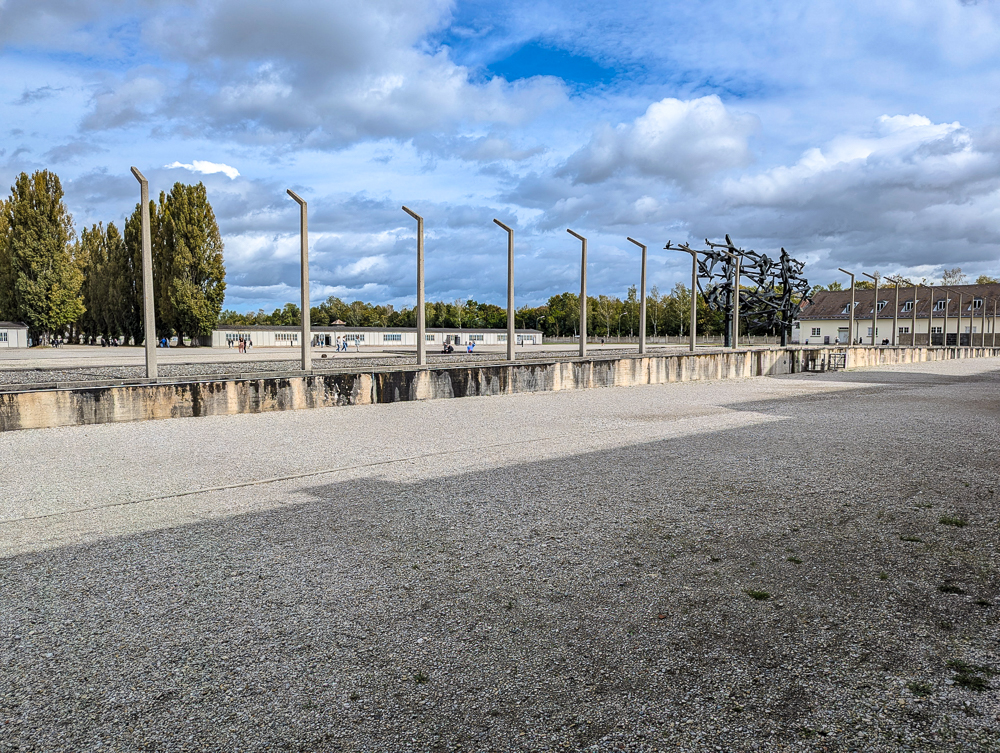

Four religious memorials + a convent
Towards the rear of the camp, you’ll find four religious memorials:
- Mortal Agony of Christ Chapel – The first religious memorial built here (1960)
- Protestant Church of Reconciliation – Initiated by the camp’s Dutch survivors (1967)
- Jewish Memorial – Opened in 1967 with a design full of symbolism
- Russian Orthodox Chapel – Dedicated to the Soviet prisoners, the camp’s 3rd largest victim group (1994)
Behind the Mortal Agony of Christ Chapel, you’ll also find the Carmelite Convent of the Precious Blood. Deliberately chosen for this location, the convent opened here in 1964 to “establish a living symbol of hope.”
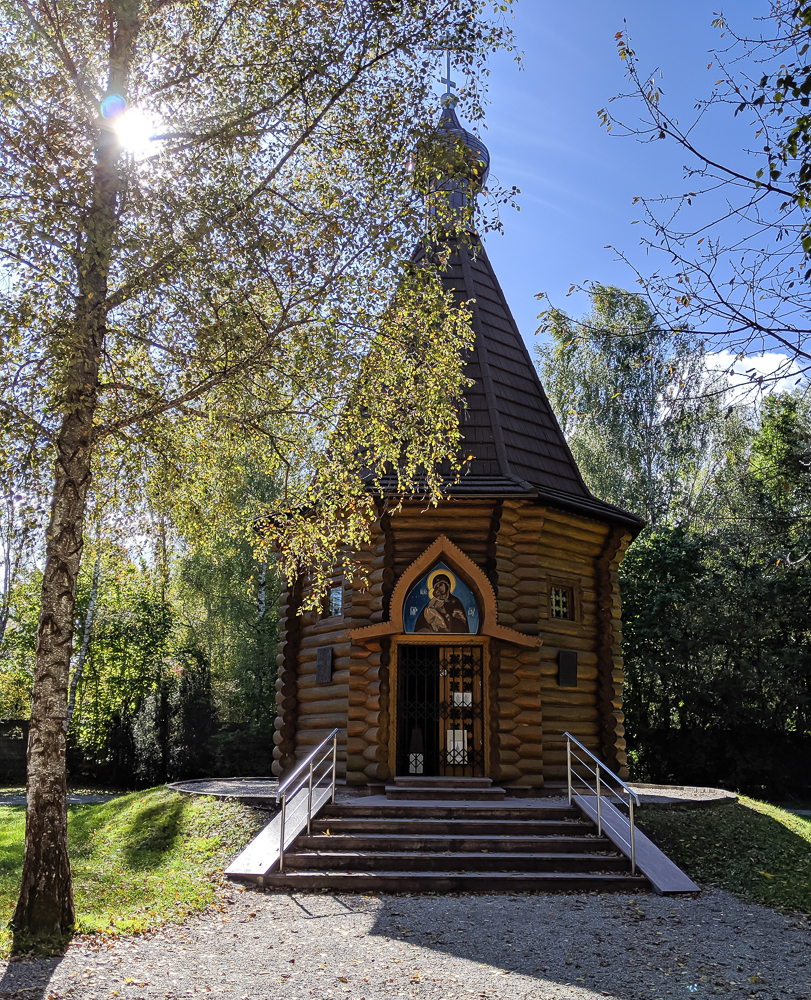

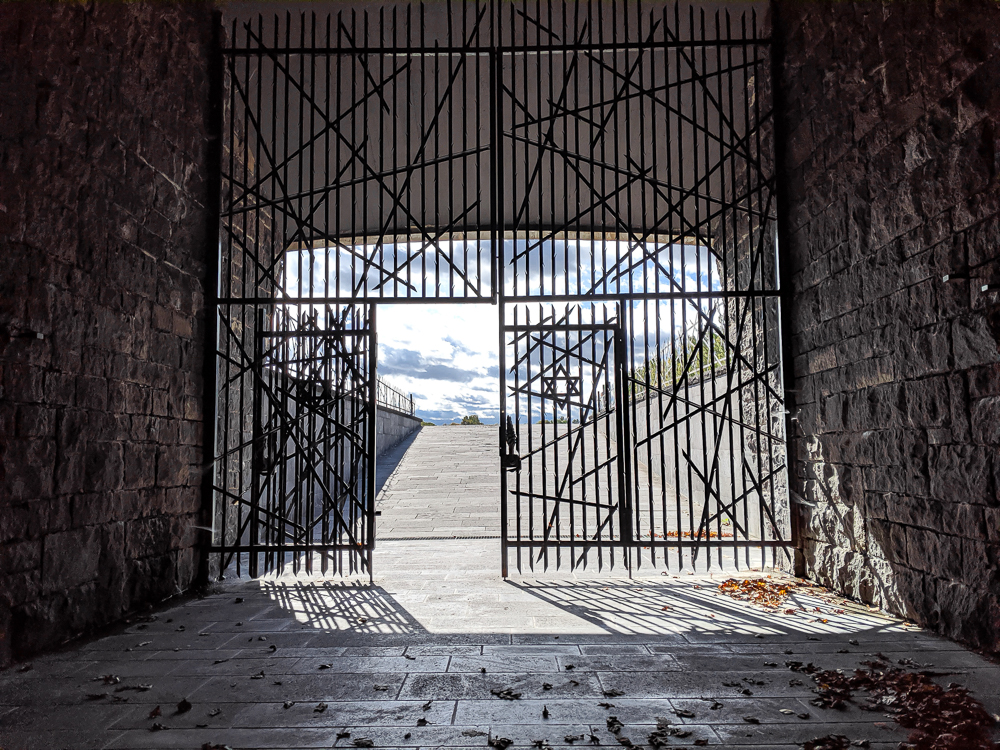
Informational panels & augmented reality
You’ll also find an enormous, wide open property that’s bigger than you can imagine. Throughout it are informational panels placed at significant spots around the camp. These make a free, self-guided tour easily possible.
You can also now experience this camp in virtual reality thanks to a new immersive app called ARt. It merges some of the former prisoners’ drawings and paintings with the scenes around you to help you better understand their experiences. More info on that here.
Related: Check out what else there is to see and do in Munich in this post.
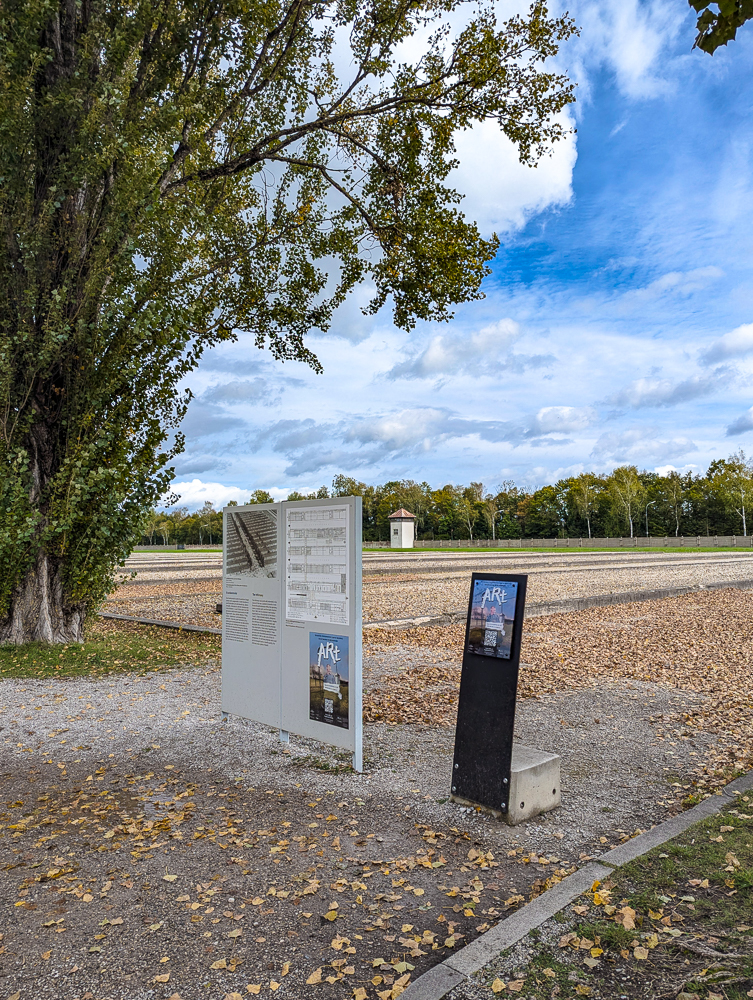
What to expect when visiting Dachau Concentration Camp
Beyond the actual historical and informative sites you can see, while visiting Dachau Concentration Camp you can also expect:
A sea of information
An unreal amount of information concerning all topics related to Dachau Concentration Camp, actually. Whether you take a guided tour, a self-guided audio tour, or simply walk around alone and read the informative panels, you’re sure to learn so much.
A somber environment
The Dachau Concentration Camp Memorial Site is just that—a memorial site dedicated to the men, women, and children who suffered and died here. It’s not a “tourist attraction.” Because of this, the site has a totally understandable list of guidelines for visitors. Please act appropriately.
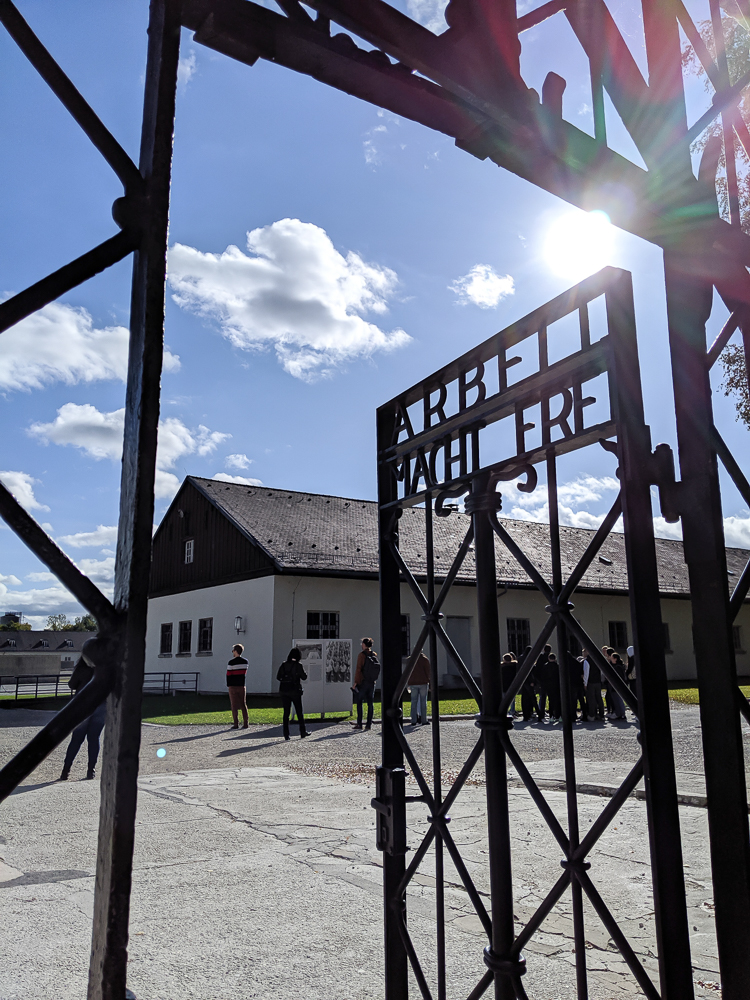
A lot of walking
The former concentration camp is enormous so be prepared to rack up those steps. Also worth noting, most of the property is covered in gravel so wear suitable footwear.
Exposure to the elements
Because most of your visit will take place outside, be sure to dress according to weather conditions—rain coats and umbrellas, sunglasses and sunscreen in the summer, warm outerwear in the winter, etc.
A new outlook
Most importantly, you can expect to look at life completely differently after your day visiting Dachau Concentration Camp.
Also check out: How to Visit Birkenkopf Stuttgart (Germany) for the unique perspective at WWII’s Rubble Hill

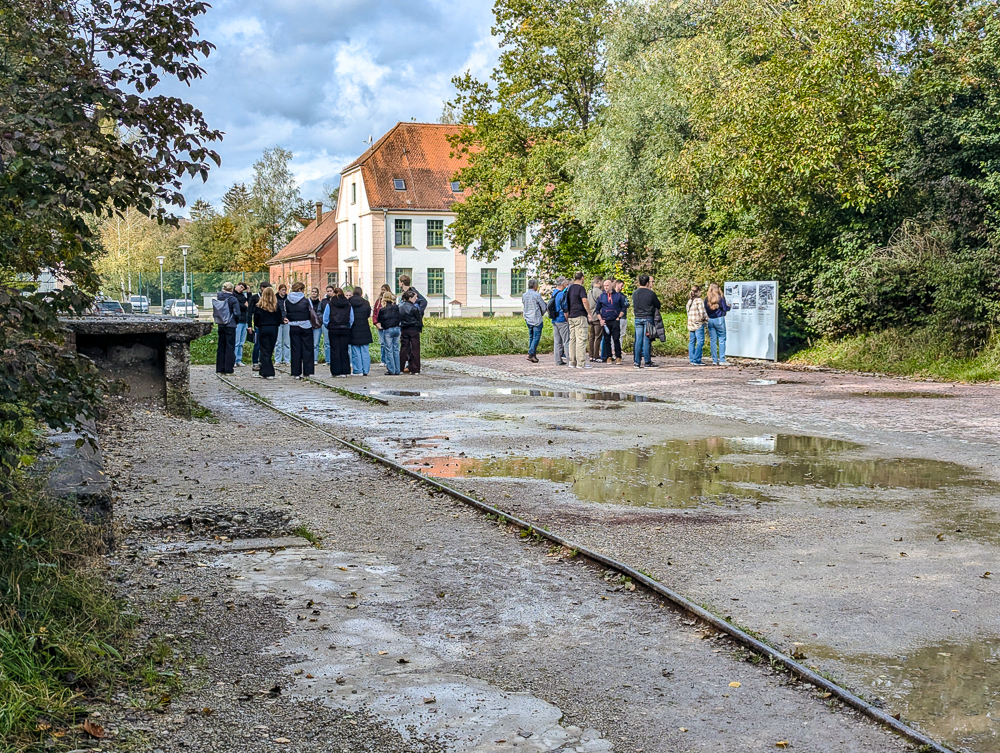
Guided tour or audio guide?
Visiting Dachau Concentration Camp for the first time, I went with one of the amazing guided tours. I have also visited using just the audio guide, and again without any guide at all. If this will be your first time, I highly recommend signing up for one of the guided tours if your schedule allows it.
Dachau guided tours
English-speaking guided tours are offered every day at 11:00 am and 1:00 pm. They last about 2.5 hours, and cost just 4 euros (about the same in US dollars).
They cover the main areas of the site in order to provide a well-rounded overview of Dachau. You’ll visit the former camp grounds, the historical buildings, and some of the permanent exhibition.
However, you’re still free to roam about the property as you wish both before and after your tour. Don’t worry that you’ll be limited to only the sites on the tour. You can spend as long here as you wish.
Tickets for the guided tours are sold on a first come basis at the information desk in the visitors’ center. They’re limited to 30 people each and they do sell out so try to arrive early.
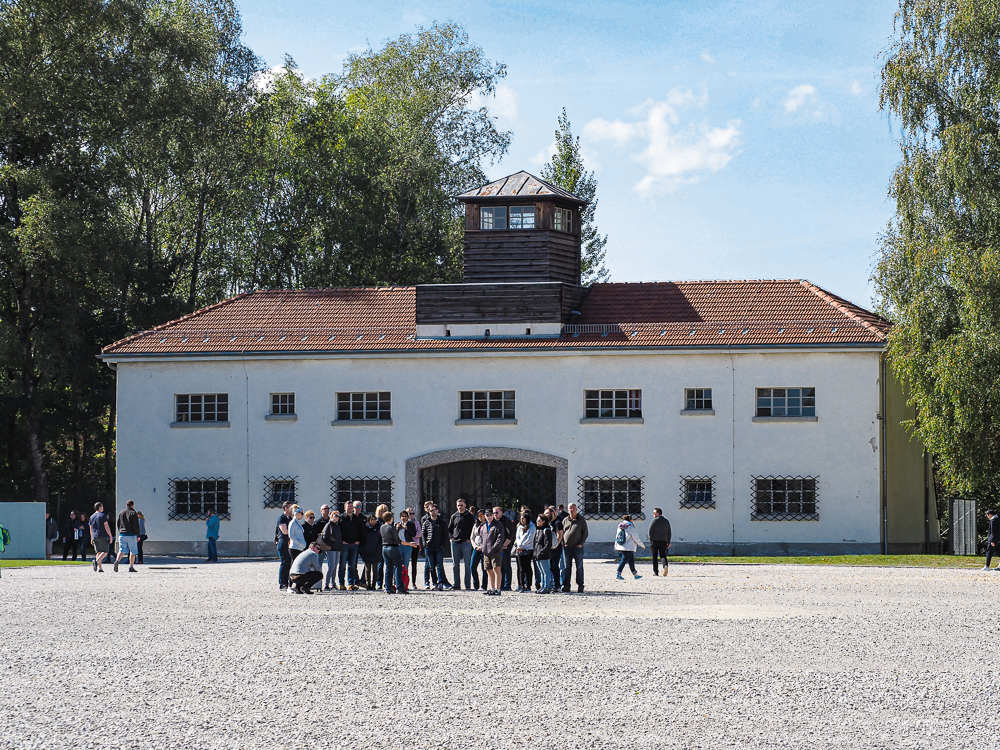
Dachau audio guide
On the other hand, I’ve also visited Dachau Concentration Camp and used the audio guide and it did not disappoint.
The audio guides provide information in 16 languages—English among them—and come with a map you can easily follow along with. They’re comfortable to wear and easy to use. They allow you to pause if you’d like to explore more of an area, do some Googling, whatever. You won’t feel bound to a group and you don’t have to follow any certain order.
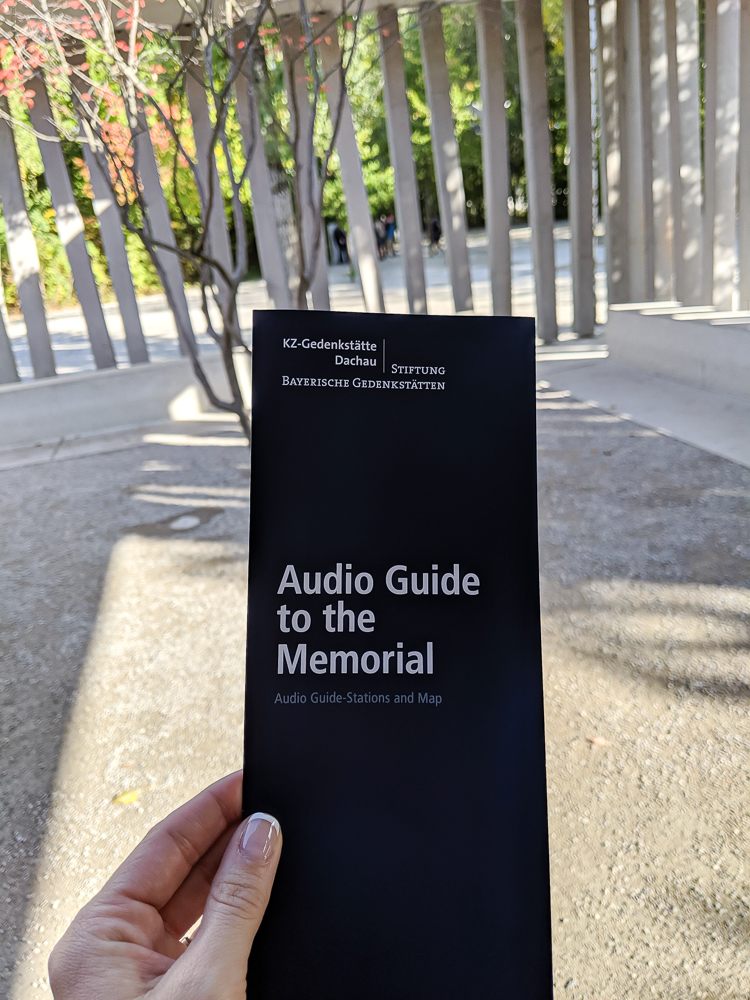
Renting an audio guide
Rental of an audio guide costs just 4.5 euros but requires an additional deposit. For this you can leave either your ID with the person at the front desk or some money. I say “some money” because I feel like their deposit policy is fairly open to interpretation.
Audio guide deposit
I didn’t feel comfortable leaving my ID as a deposit since I only had my passport with me at the time. I was told, after several minutes of digging through my purse to see what else I could leave them, that I could leave 10 euros instead. So that’s what I did.
However, upon returning my audio guide to the desk later, I witnessed another solo female traveler in the same predicament. Only after she expressed not wanting to leave her passport was she given the option to leave 20 euros as a deposit instead. Obviously, this money is returned when you return the audio guide so the amount is negligible, but still, something to keep in mind.
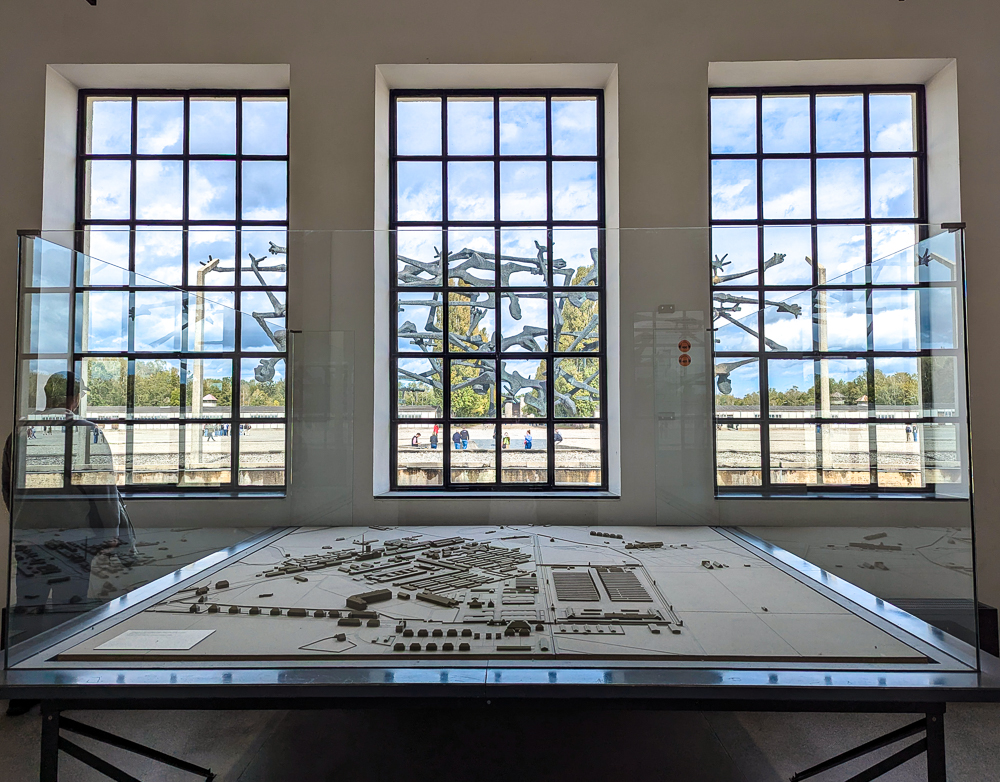
So which one is best?
The information you’ll learn through the audio guide is not much different from the guided tour. In fact, I remember some of the information on the audio guide word-for-word from my guided tour. However, with the guided tour you have the added benefit of being able to ask your tour guide questions.
In other words, you really won’t be disappointed if you decide on one kind of tour over the other.
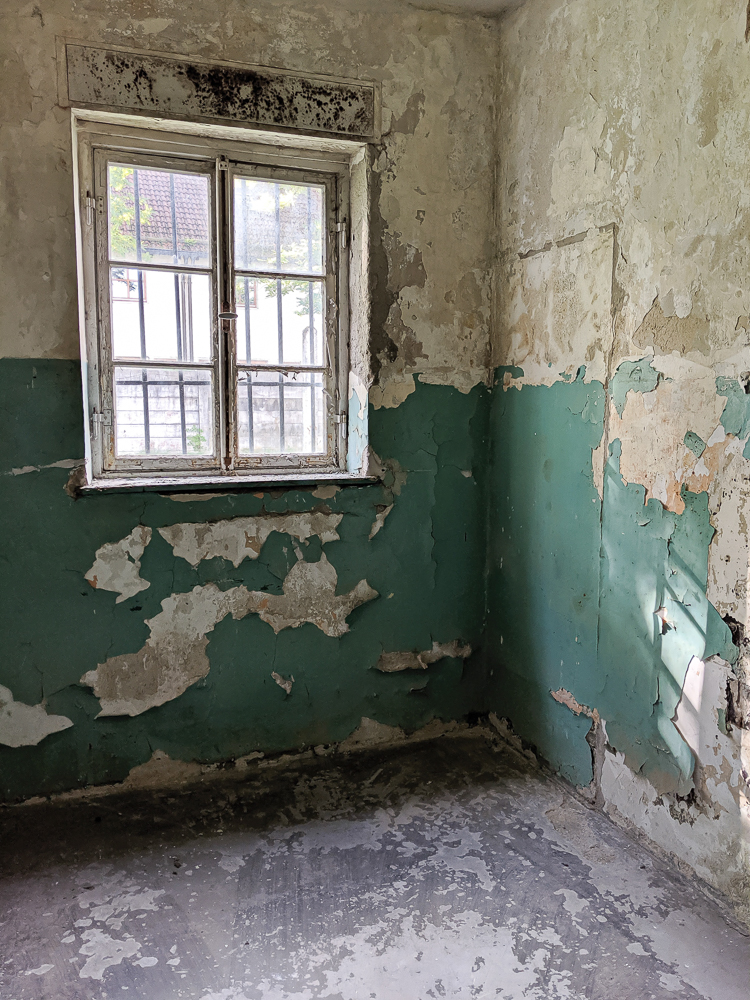

Self-guided Dachau tours
But there is a third option! If you’ve left all your IDs and all your euros at your hotel, visiting Dachau Concentration Camp is still possible.
The memorial site is completely free to visit and the abundance of written information around the site will still teach you what you need to know. You can still view the documentary film, tour the permanent exhibition, visit the bookshop, and explore all of the sites of the former camp.
Pro tip: Download the official Dachau Concentration Camp Memorial Site mobile app before your visit. It offers logistical tips and information, background information on Dachau, summaries of the exhibitions, photos, and more. The app is available for free both on Google Play and the Apple app store.

Things to know before visiting Dachau Concentration Camp
Before you head off to visit the former camp, here are a few things you need to keep in mind:
Raw history
The first thing you should know before visiting Dachau Concentration Camp is that they don’t sugarcoat the history. They don’t hold anything back and they don’t hide from their horrible past. All the ugly facts and photos are put out here for you to see and little here is subtle. If you’re expecting a discreet retelling of historical events, forget about it.
On my way back to Munich, an Australian visitor on the bus asked what I thought of Dachau. He told me he didn’t agree with them allowing visitors into the crematorium. But why not? Hiding the hideousness of the past doesn’t do anyone any favors. (Well, except the Nazis.)
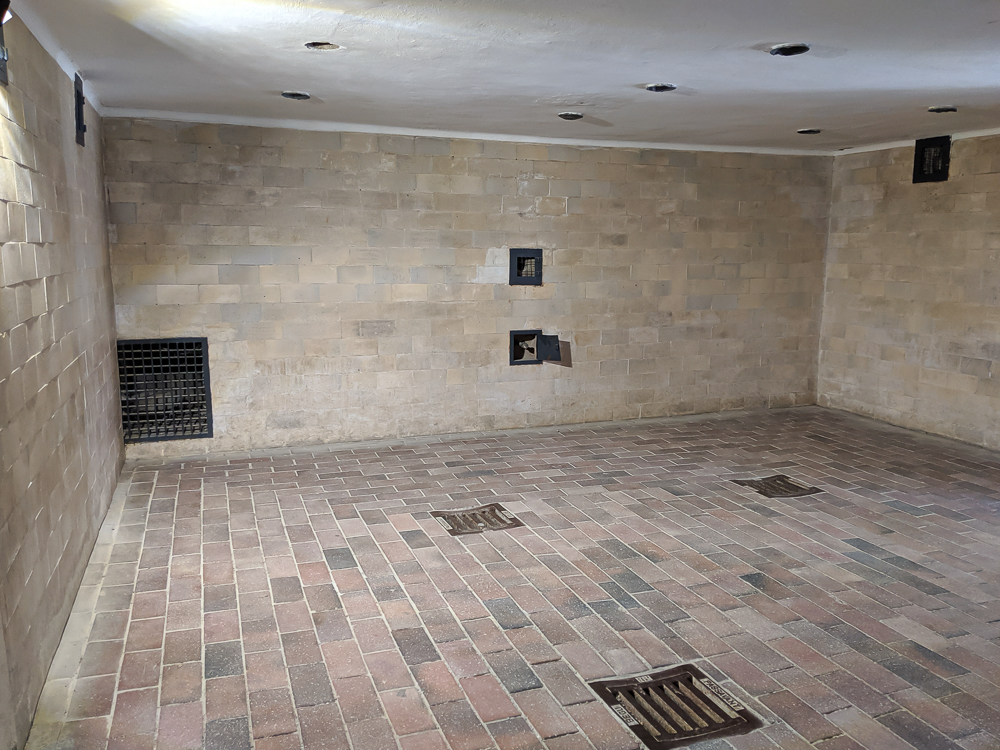
In fact, the former concentration camp that is now the Memorial Site was established “on the initiative of and in accordance with the plans of the surviving prisoners” who joined together to form the Comité International de Dachau (the International Dachau Committee) before the camp was even liberated.
It’s because of this committee and its members that the demolition of the former crematorium was halted in 1955. And it’s because of them that the former camp became an official memorial site in 1965. Opening the crematorium to visitors, for instance, is not exploitation.
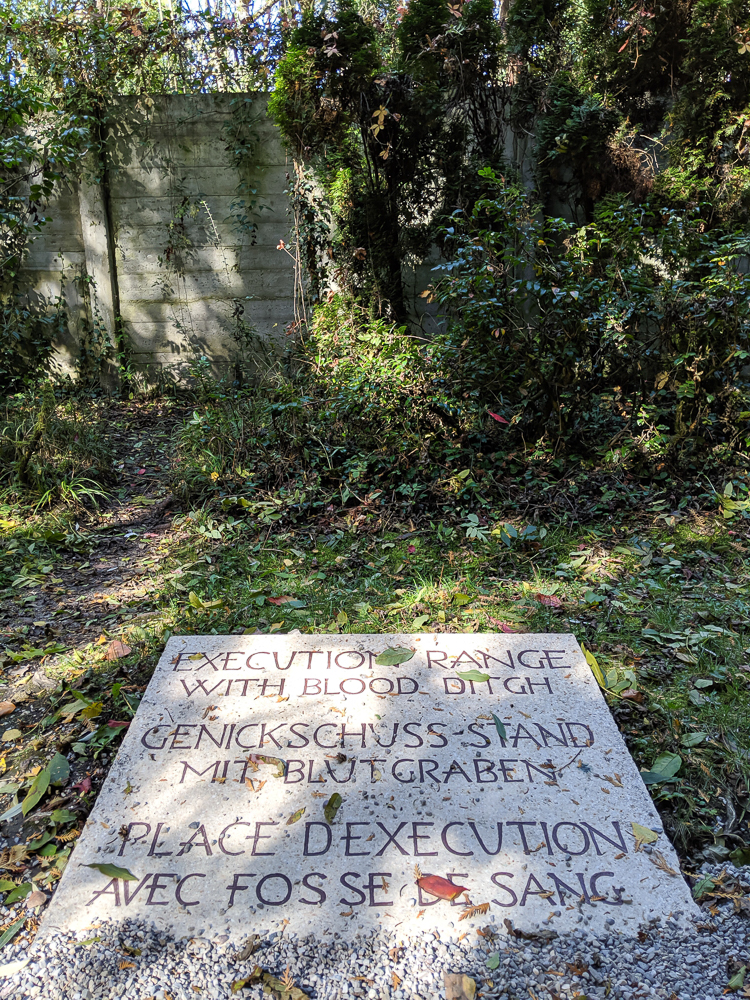
How long will a visit to Dachau Concentration Camp take?
Expect visiting Dachau Concentration Camp to take you around 4 hours. There’s a lot to see here and it’s not the kind of place you can rush through, especially given its size. Plan for a half day (plus an hour to get here and an hour to get back to Munich) to be safe. Most people only visit Dachau once, so be sure to give it its due.
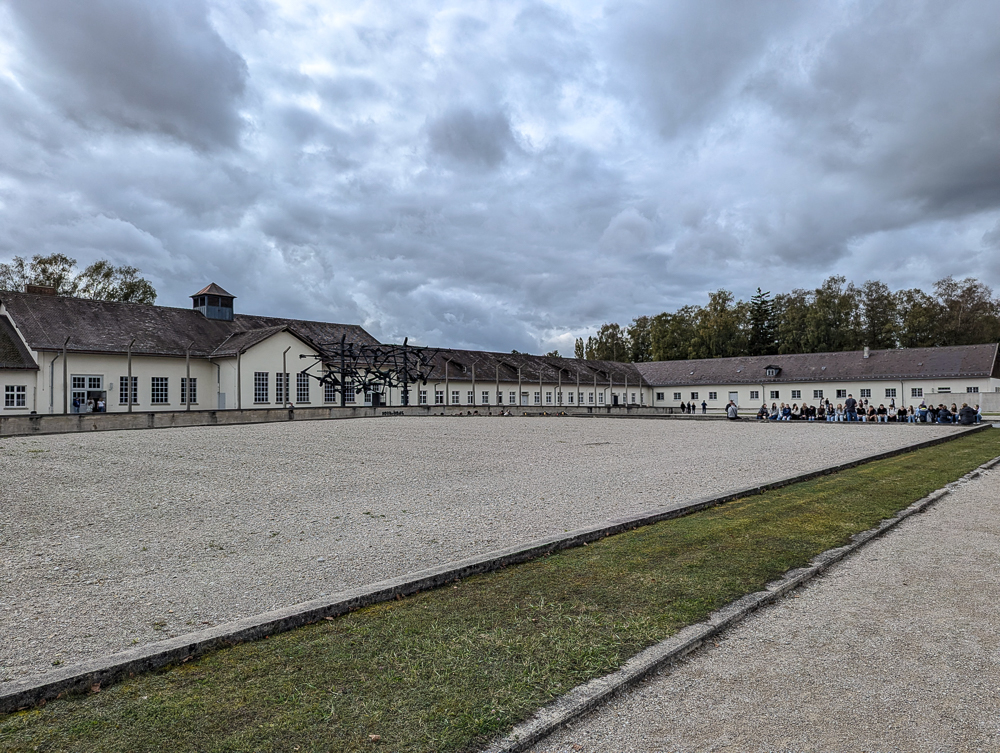
Is there a place to eat lunch?
The Dachau Concentration Camp Memorial Site has an on-site cafeteria that serves snacks, drinks, a variety of hot meals, coffee, sandwiches, desserts and much more. It has plenty of indoor and outdoor seating as well as reasonable prices. You can view the full menu and get more information here.
Eating and drinking anywhere else at the former camp site is prohibited. Since you’ll be here for so long, make sure to plan for lunch in the site’s cafeteria. If you wish to bring your own snacks, you’ll need to leave the premises to eat them.

How to dress for your visit
While here, you’ll spend most of your day outside so dress according to the weather. Also be sure to follow Dachau’s visitor guidelines regarding what you should and should not wear in terms of what’s appropriate and respectful.
On visiting Dachau Concentration Camp with children
The Memorial Site warns that some of the content may not be appropriate for children under the age of 12 but it’s at the parents’ discretion whether they bring their kids or not.
Children can visit when accompanied by their parents however they restrict guided tours to visitors ages 13 and up and the documentary film inside the permanent exhibition has a minimum age requirement of 14. The sign at the entrance to the permanent exhibition says children under 12 are not recommended to enter.
For more on this topic, see my post on visiting concentration camps with kids.

How to prepare for your visit to Dachau Concentration Camp
Here are some of the things you need to consider before your visit.
What to bring with you
Here’s a list of things you should and/or might want to bring with you on your visit to the Dachau Concentration Camp Memorial Site:
- Tissues – You’ll definitely need them
- Weather appropriate clothing and outerwear – That includes scarves, hats, and gloves in the winter; a sun hat, sunscreen, and portable fan in the summer; a rain jacket and/or umbrella
- Walking sticks – There’s a lot of ground to cover here and most of it is covered in gravel
- Outdoor shoes – Lots of walking, gravel, and mud mean you should wear some good outdoor-appropriate shoes
- Refillable water bottle – You’ll be here for a while; gotta stay hydrated (just be discrete about it)
- An ID or some extra cash to use as an audio guide deposit
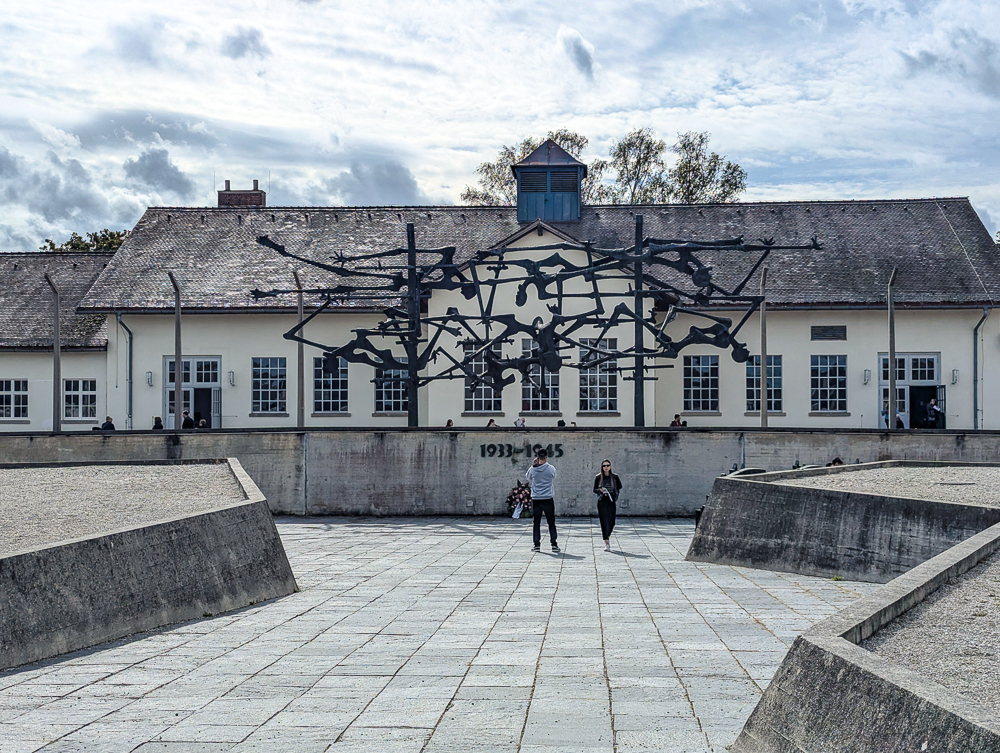
Site accessibility
The memorial site has taken some steps to make the site more accessible to all visitors, but it still presents its challenges. (The gravel, for instance.) However, here are a few things to know:
- Wheelchairs and e-scooters are available to borrow
- Many of the buildings have ramps – like the maintenance building, reconstructed barracks, crematorium, and more
- All indoor spaces and restrooms are wheelchair friendly
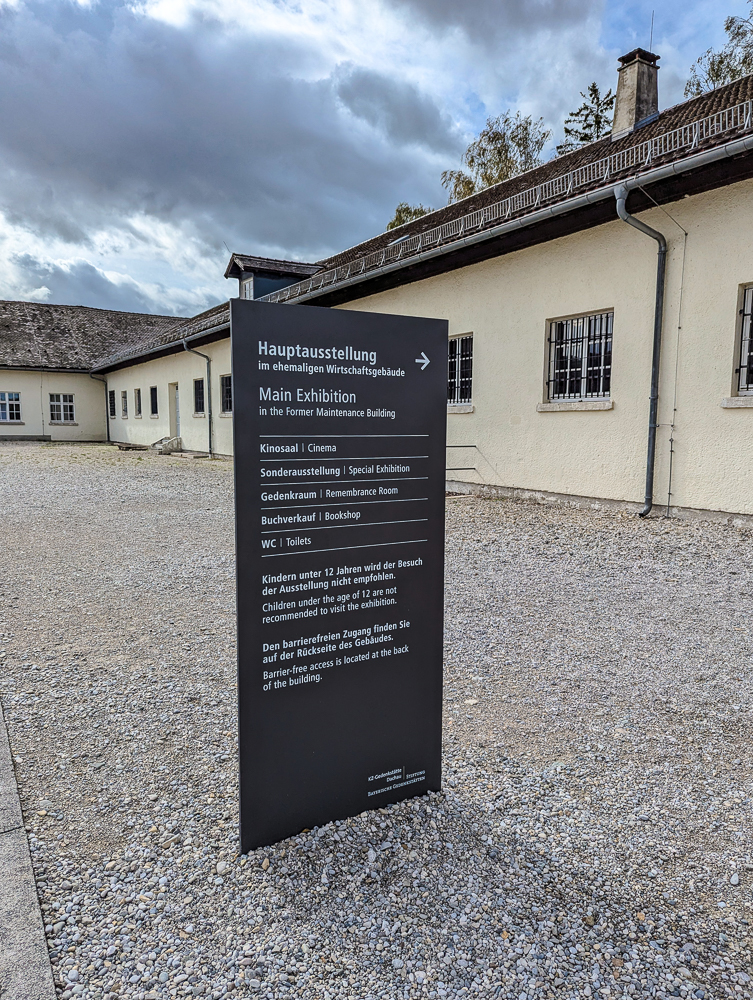
Visiting Dachau Concentration Camp: necessary info
Dachau hours
Dachau Concentration Camp is open daily from 9am – 5pm,364 days a year. It’s closed only on December 24th.
Dachau costs
- Visiting Dachau Concentration Camp is free. (There’s no entrance admission or ticket required.)
- Guided tours cost 4€
- Audio guides cost 4.5€ to rent + a refundable deposit
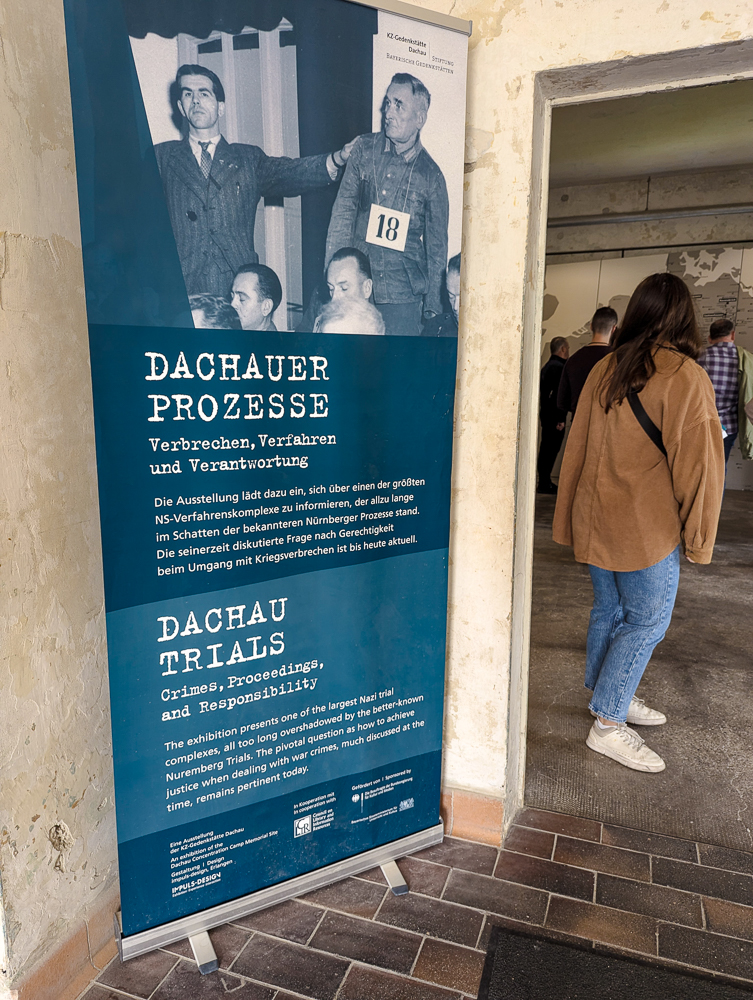

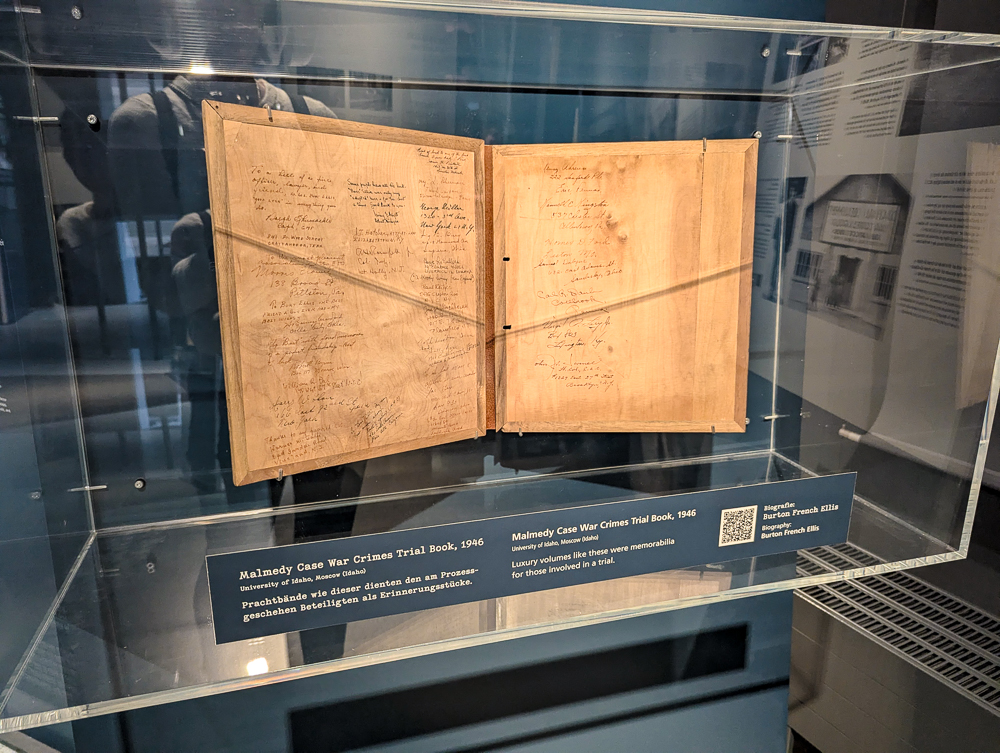
Here’s hoping you have a terrible day visiting Dachau Concentration Camp.
(That means you learned a lot.)


More resources for visiting Dachau Concentration Camp
- Hotels: Find great places to stay in Munich here on Booking.com (but Hotels.com and Expedia are also worth checking). VRBO is best for apartment rentals.
- Rental cars: Check out the best local rental car deals here.
- Travel planning: Don’t forget a Germany guidebook and this Germany customs and culture guide
- Local tours: See all the great options from Viator and Get Your Guide here.
- Want more? See all my Germany posts here.
Like this post? Have questions about visiting Dachau? Let me know in the comments below!

Save this info, pin these images:



Ashley:
Excellent work by you. Great job!! My father (Jack) was a Bombardier with the 384th Heavy Bombardment Group/546th Sq out Grafton-Underwood UK 7/1944-3/1945. I found a website-(384thbombgroup.com if others would want to search for relatives) put his name in and it gave a list of his 31 sortie/missions. B-17 Tail #, Pilot,Co-pilot,Tail gunner etc. On missions- If the primary target (say Synthetic Fuel Plant) was cloud covered, they would unload on the city centers (Cologne, Munster etc.) and the poor civilians. Wow. Collateral damage. War is hell. I wish he was still here, I have so many questions. I traveled to Munich Sept 2024 and toured Dachau. Yes- “sobering” it is. Went on down to Berchtesgaden and toured that area. I can see why their leaders had homes there-Alps- so beautiful. I’m planning to go back- there’s so much to see. Take Care.
Thank you, Joseph! And what a gift you have with all that information about your dad. I was at Dachau again in Sept 2024, maybe we passed each other. 🙂 And I’m glad you went to Berchtesgaden too. There’s so much fascinating history there!
This is a truly excellent guide. Interesting, informative, completely admirable in the amount of time and careful research you’ve put into it to seemingly answer every visitor question and concern. I visited Dacau many years ago and it is indeed a sobering and profound experience.
Thank you so much, Kevin! I really appreciate that. I’m glad you’ve had the opportunity to visit Dachau.
Wonderful article. You sum up a visit to Dachau brilliantly. I was stationed in West Germany 1971-72, and visited Dachau, thrice. I’m going back next week, and a tour of Dachau is on our agenda. I’ve been telling the two couples coming with us what to expect, but your words and images provide a much better description. Thanks so much.
Thank you so much Peter; I really appreciate that. I hope you have a great 4th visit and thank you for bringing others for the first time.
Hi Ashley, extremely interesting reading this. I will be a part of a family group from U.S. going to Krakow, Poland in the summer 2025 to tour and visit distant relatives. My father was in the U.S.military, WWII, and at Dachau as part of the liberation. I want to make a solo stop to visit Dachau before getting to Poland. I know there are many places to visit in Munich but my main reason is to visit Dachau. Is there any place else that you would recommend that I “must” visit? How many days/nights minimum would you recommend I stay in Munich. Thank you very much.
Hi Marie, That’s going to be a great trip. I’m not sure if you have seen this or not but I have a whole post about Munich WWII sites and also a complete 1-day WWII Munich itinerary that you might be interested in. If you’re interested in more than just WWII stuff, at least 2 days in Munich would work, but 3 would be great if you spend half of one of those days at Dachau.
Of the WWII sites in Munich, the ones I would suggest as “must-visit” would be the NS Documentation Center (more info here) and the White Rose exhibit at the Justizpalast. Beyond that, here’s a tip: instead of taking the bus from the Dachau train station to the memorial site, you can actually walk there too. Along the way are a bunch of related historical sites and information panels. Just a little something extra you can see related to the camp at Dachau if you’re interested. I’ll be writing more about these later, but here’s a page to get you started: http://www.dachau.de/en/tourism/concentration-camp-memorial-site/commemorative-sites.html 🙂
Hi Ashley,
Thank you for the detailed instructions! I wanted to know if I needed to reserve a spot going to Dachau ahead of time or if I can just plan to go on the day of
Thank you. I plan on going July 25th or 26th
Hi Andy! There are no reservations at the Dachau Memorial site so you’re welcome to show up that day without advance notice. The guided tours tend to fill up so they ask that you show up and buy your ticket at least a half hour in advance. But if they are full, you can still rent the audio guide which is also great.
Thank you for the info and all the comments. Visiting this site is on my bucket list, and i Know i wil have to walk with a box of tissues.
Yes – you’re right about that!
Hi Ashley, Thank you for all this incredible information! We are planning a trip to Munich in May. I am trying to prepare myself, but know that this will be raw and emotional, and I am sure all the mental preparation in the world will not be enough.
Hi Roberta, You’re right; it’s heavy, but so worth a visit. Enjoy your time in Germany!
Hi Ashley,
I visited Dachau back in 1989—the summer before the Berlin wall came down—and found it deeply deeply moving. I recall a glass display case filled with hundreds of prisoner shoes, I’ve been searching the internet to see if those shoes are still there for a piece I’m writing. I note from your excellent write-up that the exhibition has changed over time, do you happen to know if that display is still there? Perhaps I’m getting confused with a photo of shoes?
Thanks for taking the time to answer,
Sim Carter
Hi Sim! I don’t remember the pile of shoes from my trips to Dachau, but there is a well-known photo of them there. You can see that photo here. However, I believe there is a large pile of prisoners’ shoes on display at Auschwitz. I also remember a large collection of shoes at the US Holocaust Memorial Museum in Washington DC. Perhaps there was such a display when you were there in ’89.
Hi Ashley,
I just came on this site, and complement you on it. Well done! I visited as part of a tour group from the American Jewish Committee, in the late 1980s, that visited various sites in Germany and talked privately with a number of very interesting individuals, active in German politics during and since WWII. I have vivid memories of Dachau. I would like to run some of these by you and ask if what I remember is still there.
The pictures show that the ovens are still there. When I saw them the contents included fragments of identifiably human bones. Also, as mentioned in an earlier post above, the open gravel area gave of a terrible smell of burned flesh, on a cold and humid day.
Very near the entrance was a signpost, about twice the size of a No Parking sign, with a ceramic-on-metal sign of medieval roof lines and a text in German that read something like:
“Dachau, a town of poets and dreamers.” There was graffiti on it in multiple languages to the effect of “B.S.” and other versions of disbelief. Then we turned left and entered the visitor’s center. First was a large room whose whole left wall was covered with a map of Europe, showing the locations of ALL the concentrations camps, not just the famous ones, and there were many. Then on the right a room that had dedications left by visitors, mostly framed photos and framed cards, that seemed to be mostly by relatives of Polish POWs. Then next came a long linear gallery. The first exhibit on the left was a copper printing plate with a paper print-out, that was the front page of the Municher Zeitung (Munich Times) in 1933 announcing the opening of the camp for political undesirables. It struck me then that if you saw such an item you would know something was seriously wrong, and that has not changed. After that was a series of photos of tortures, one of a man hung by his hands under the watchful eye of an SS soldier. When my group emerged we were all crying, except for our two simultaneous translators, who were young German women who had answered every question we asked in normal circumstances. We asked why they weren’t crying, and they said that they did not look at the pictures…..I will never forget this experience. Like you, I recommend the visit to Dachau as important to everyone.
Hi William, thank you so much for sharing your experiences! The way Dachau has been presented to the public has certainly changed over the years, so it makes sense that someone who last visited in the 80s would have seen different stuff that what’s presented today. (More graphic and honest stuff, truth be told.) Your stories are so interesting!
Hi Ashley,
I am so looking forward to a trip to Dachau now. Please tell me, does the guided 2 1/2 tour in English include watching the documentary in English or shall I plan to watch the documentary before/after the tour time? I need to know because time is short on the day I can go and I want to plan it so I don’t miss a thing.
Thanks in advance for your reply!
Hi Imelda! I’m so glad to hear that. I can’t remember in what order I did the tour and watched the documentary, or if it was included in the time. I’ve reached out to someone at the memorial site for the answer so I’ll update you ASAP.
That is so kind of you as I cannot find the answer online, so I really appreciate your help. Eagerly awaiting their response to you.
Hi Imelda! I heard back and they confirmed that the documentary is NOT part of the tour, so you can watch it either before or after your tour time (or whenever works best for you). Enjoy your visit!
In 1958 I was in Munich en route to visit an Austrian friend from college. The young woman who was at the car rental counter was very attractive and spoke perfect English. So I asked her out to dinner, thinking she would be the ideal city guide. She accepted but said we must first take her mother home. As her mother worked in my hotel, that was easy. I saw the signs to Dachau but became increasingly distressed as we entered the city and then the camp itself. Her mother lived in one of the barracks – there was still a housing shortage in Germany 13 years after the war – which she had decorated with flowers. She made no attempt, however – perhaps she was not allowed to – to hide the signs which identified (in many languages, including English) the torture pit and blood ditch behind her house. All the mother could say was “Arme Deutschland” (poor Germany) over and over. It was more than I could take; I left my date there and returned to Munich.
A sort of coda: Many years later I was living in Germany with my wife, an American diplomat assigned to the Embassy in Bonn. On German TV I saw an old man being interviewed by a very young girl reporter. She asked him what he and his neighbors in Munich, living just 15 km from Dachau, thought about the camp. He said, “What camp? We knew nothing about any camp.” The reporter said, “But come on, you must have smelled the burning flesh.” He repeated that he and his neighbors knew nothing about any camp,” and added, “and we knew that if we said anything, they would send us to that hell-hole.” She could not believe what he had said – perhaps he was hard of hearing – so she repeated her question, and he repeated his answer, word for word.
Those are such interesting stories, George! Thank you so much for sharing. “We didn’t know what was happening” was an incredibly common line in Germany post-WWII. I wrote a paper last year about Dachau’s use as a refugee camp/housing solution after the war so I find it so fascinating that you were able to go there during that time.
Thank you Ashley. I am glad I stumbled on your article. I was stationed with the U.S. Army in Herzogenaurach, Germany, from 1967-1969. I visited Dachu once back then. I will return to Germany in December 2024, as I promised myself 50 years ago. I am taking my wife and wanted her to experience that evil place. I told her what many of your readers have said, “It will change you.” Thank you for your article.
Thank you so much for your comment Ramon. I’m glad you’re able to stick to your promise after all these years!
Making a pilgrimage to Dachau is a travel dream in the making since I was 18. I’m knocking on the door to my 70th birthday, and I’m finally planning this for my family in either 2025 or 2026. My eldest grandson, now 19, is awaiting a kidney transplant. I’m hopefully in 2-3 years he will have graduated from travel restrictions. But I digress… My grandfather, Col. Earl B. Ross, MD, led the medical team into Dachau when the Allies liberated the camp. He did not speak often about his war experiences, except to share mostly benign and humorous events. I was deeply interested in learning about WWII because of Gramps, and at 17 I assumed there would be plenty of time to learn from him. But he died from the effects of a massive stroke when I was 18. What I was not able to learn directly from him, I have promised myself to go, see and learn from the actual site. When I go, I will be accompanied by my son, his wife, her parents, and my five grandchildren. It won’t be Disney World, but I believe it is important to understand our family’s role in history and to learn how absolutely essential something like this, the camps, never happens again. Your guide will help us all prepare better for the experience. Thank you so much!
Hi Suzanne. What a story! And a familiar one – so many of us lost our loved ones who served before we were ever able to talk to them about it. You’re right though, it’s not Disney World but it’s definitely an important place to visit. I hope you get there and enjoy your time visiting with your family. 🙂
Thank you for your article.
I visited Dachau alone, as a 19-year-old, over 50 years ago in late summer 1972. I was stunned by the horror inflicted by human beings upon other human beings.
I took a break outside, and sat cross-legged on a small patch of grass. I looked down, and found a four-leaf clover…the only one I have yet found in my life.
A few days after that, I was at the opening ceremonies of the Munich Olympics; then a few weeks later, at the closing ceremonies.
Great Joy, then great sorrow.
I can only hope that whatever I learned at Dachau, and its tiny gift to me, has helped me make my small part of the world less horrific.
That’s beautiful Shawn, thank you so much for sharing!
I am a retired American living in Spain. What is the best part of the year to visit Dachau? Is it difficult to get around (Rental Car) if one does not speak German? Accomadations?
Thank you.
Hi Louis – Anytime would be a good time to visit Dachau actually. Obviously temps are colder in the winter but conditions aren’t that bad. There will likely be more crowds in the summer. And no, it’s not difficult to get around in a rental even if you don’t speak German. There’s even on-site parking at Dachau too.
I visited Dachau in October 1966 and was unable to get directions from anyone. Embarrassment was everywhere. The pictures and everything there had a chilling effect on me that is still vivid today. People of the world need never forget the atrocities of Hitler and those around the world like him. RIP my friends.
Hi, thanks for your post. I have a long transit period at Munich airport and have been looking into visiting Dachau during this time. Any advice?
Hi Emma! That’s easy. To get to Dachau from the Munich Airport you would just take either the S1 or S8 from the airport to Munich Hauptbahnhof, the main train station, and then follow the directions in this post. The train from the airport to Hbf takes about 45 minutes, costs €12,30 and the trains leave every 10-20 minutes. So follow the directions in this post on how to get from Munich to Dachau, and just factor in another 45 minutes for the train from the airport and any time you have to spend in customs, storing your luggage, etc. Good luck!
My family visited Dachau either in 1967 or 1968. I was born in 1960 which would place me at about the second grade. My mother had taken a home movie which we eventually used for school reports along with literature we received. My experience at Dachau has influenced my entire life. I recall a photo of a mountain of shoes from the victims. I recall walking through the gas chambers and the crematorium. In 2010 while on vacation in DC I insisted my husband and children visit the Holocaust memorial, wanting them to experience the impact Dachau had on my life. Honestly, they couldn’t take it. Couldn’t get out of there fast enough. It’s been over 50 years since my experience and still recall the presence of sorrow, despair and evil that permeated the air and every fiber of my being. Truly a life changing experience
Hi Terri – thank you for sharing. I agree that it is a life-changing experience. I said the same thing during my first visit 10 years ago. Now, a significant part of my life revolves around sharing WWII history and a lot of that started with my visit to Dachau.
I have visited Dachau twice. Every time I visited I learned something else. There is alot to see and feel. You will go through so many emotions. It is very somber and I would not take kids until they are older. There is one building where a female British pilot was hanged and it states exactly the spot, so young kids should not visit. Some claim it is haunted, I wouldn’t doubt it with all the sorrow in former camp.
Hi Melissa, it’s true that you learn new stuff with each visit. It is very somber, but I do believe it’s something everyone should see. (At least, past a certain age.) Thanks for stopping by!
Don’t worry about the kids – they need to know -kids survived the camps and did wonderful things. We need to quit over protecting kids.
I have never visited Dachau but I have visited the holocaust museum in the city where I live…I was not born when this happened but it has touched me greatly…my ancestors came to the US in 1842 on the Dunstan…two brothers and their wives and children…left Mutterstadt Germany by way of going through France to Paris where they caught a ferry to the ship Dunstan…so with that being said I know they left the rest of the family behind…my family’s last name is Weiss…and yes Jewish…so I know that I had family in dachau, auschwitz, and probably more places…a couple months ago I came across some pictures from Dachau from my great uncle on my dad’s side of the family…I have a picture of the crematorium that you have a picture of in your article…and I found a picture of my great uncle on another website just after it was liberated…I think what you do is wonderful because we need to make sure future generations learn from what was done and to never repeat the past…history is there for a reason the good, the bad, and the ugly side of it…may God grant you safe passages for your future travels and God bless you…
Wow thank you for your comment Beth! I appreciate you sharing your story with me. I hope you can make it there yourself some day.
I was looking at photos of my student exchange trip from the early 90s and came across ones I took at Dachau, it prompted me to look it up again. I’m so very glad I was able to go, but wow even as a fresh and naive 18 year old it was chilling. The bone sculpture hit me… To think of the horrible things that happened there truly is sobering. IMO anyone who is able should visit a camp memorial, such a key (albeit horrible) piece of our history that should never be forgotten.
Hi Tanya, I agree that everyone should visit one of these camps if they have the chance to. Thanks for stopping by!
My dad was in WW2 going from Utah beach to Germany. In 1975 he brought me to Dachau while on a family vacation to Europe. I think it was more to ease his mind about the things he had seen than a vacation. Even only being 15 at the time, the memory of that visit has stayed in the back of my mind all these years.
Wow, what a story. It certainly is an unforgettable place.
Great article explaining the site and why it is so important to continue to show mankind what happens when freedom is taken away by a dictator and despot. Keeping teaching this kind of history even if it makes others uncomfortable.
My wife and I visited Dachau in 1978 while I was stationed with the US Army in Germany. The massive stink of the Camp in 1978 still remains with us both today and I can even smell it while I am writing this post in 2022. One part that is missing in your post is by the SS Barracks was a rifle range where Russian POWs were used as “Live” targets for practice by the SS Guards. Please include this as part of the camp history.
Thank you Gary! I agree–everyone should visit Dachau at least once and really pay attention to the information and the message.
Visited Dachau on August 29, 2019. It was very disturbing to realize the atrocities that occurred here. As we were walking our tour, I swear I saw a window shade go down in one of the buildings. And there were large blackbirds walking along the street with all the birch trees, (after passing the church area.). Certainly eerie. The evil of that era must be remembered…it is now 3/2022. We are forgetting, what we said we would not.
This is so well written and explained article. Thanks a ton. Absolutely no gap left in covering all the aspects of the trip. Simply brilliant!!!
Thank you Girijesh!
Hi Ashley, I stumbled upon your write-up about Dachau and was blown away at the information and the photographs. I am flying into Munich and renting a car at the airport and want to drive to Dachau on my way south (it’s not quite on my way, but a small detour.) Did I read that there is parking at the place? Thanks, and hope you see my post!
Hi Kamala! Yes, there is parking on site. Here’s the address and note that it’s €3 to park. 🙂
I’ve been to Dachau just once – with my husband in 1970. Hard to believe that was just 25 years after Dachau was liberated and the war ended.
We had a different experience than those described here. We had purchased a VW Bug in the US, which we then picked up in Germany to begin our 3 week vacation traveling with Frommer’s Europe on $5 A Day. Yes, we were young and poor and actually followed it!
We thought we had allowed enough time to get to Dachau and see everything, but we got lost and could NOT find it! My husband was fluent in German, but when we would stop and ask local people along the way where the camp was, they would all just shrug and shake their head, “No,” as if they had no idea what he was talking about. There were absolutely NO road signs to the camp. It was as if no one wanted visitors going there. We lost a good two hours just trying to locate it.
Finally we stumbled onto it, with maybe 20 minutes till closing. The museum had already closed. But I remember the general layout and most especially the memorial with the twisted metal “bodies” sculpture. They also had “Never Again” in 5 languages as part of the memorial. I have one photo of that.
I’ve been back to Germany 3 or 4 times since 1970, but I never went back to Dachau. However, a few years ago I visited Israel and The Holocaust History Museum. It is stunning!!
Huge, complete, and heart breaking! I definitely recommend that if you’re in Jerusalem.
So my experience at Dachau is a little different from yours, but still extremely meaningful, especially when combined with other related experiences in my life over the last 51 years . . .
Thanks for sharing Joan! What an interesting experience! I will definitely remember your suggestion for Israel.
I remember the KZ shortly after the war. Then many years later again but I was retired. I was rather sad that the place looked more like a city park. Many of the items such as the dog cage’s,
hanging tree. blood trench were missing. the ovens have been cleaned out and the grey metal shower heads had been removed and I believe the ceiling of the gas kammer has been covered over. I feel it takes away from the horror the those who lived through that there and those who did not come back out the main gate. A well kept clean park. It would give people a real sense to smell and see the way it really was.
Wow, I bet it was much different so soon after the war. I haven’t seen some of the places you mentioned but I did find the shooting range and blood trench back behind the crematoria though it’s in a wooded trail. I agree that sites like these shouldn’t remove their worst parts, but I do think they’re still able to paint the same images for visitors.
ASHLEY
Thank you for the well done article on Dachau. It brought back many memories. I was Stationed in Augsburg, 50 years ago. Dachau was about halfway from Augsburg to Munich and the shortest way was to drive through Dachau. Also, back then there were no cell phones (of course) and no direct dial calls, so all calls had to go through the switchboard which was in Dachau and the Operator would say “Dachau, dial your number” which always gave me creeps. Finally, the military prison was in Dachau . I took my wife and kids to Europe in 1992 and we all went to Dachau, as one of the posts said, a sobering experience for all. This was my third trip to Dachau, I went twice in 1965-66, once before the memorial and once after, and my recollection was the more sobering experience was before the memorial.
I hope the German people will always keep memorial open.
Thanks again for the post
Thank you for your comment and your story, Don! I agree, I hope the memorial stays open forever and that everyone gets a chance to experience it.
Just wanted to say thank you for this post/blog. My friend and I are visiting Dachau tomorrow and it will be for both of us our first concentration camp. You said it best, hope to have a good day which means learn a lot. Thanks again.
You’re absolutely welcome Alexander! I hope you get a lot out of your visit.
I visited Dachau with my husband and 3 month old in April 1977. We were stationed up in Wurzburg, and had come to Munich to register our son’s birth at the American Councilate (sp). We had planned to see the Olympic Stadium but got on the wrong road and ended up at the camp. It was a visit I shall never forget. Reading your comments brought back a lot of memories of walking through the grounds, seeing the photos on the walls, the memorials, the ovens. I remember walking out the back of the room with the ovens and saw a beautiful stone menorah. I remember one area where we crossed over a river. My husband told me the river was filled with blood during the war. I’ve never been able to find any info on that.
Seeing the camp was very emotional for me, but I am glad we went. A memory I will forever hold onto of a human tragedy that must never happen again.
That’s such an interesting story! How you meant to go somewhere else and ended up at Dachau – like it was meant to be. It’s one of the most sobering experiences out there for sure. And as you’ll see, not much has changed since 1977. The stone menorah is still there, and you still get to walk over the river. Thanks for your comments Deborah!
Ashley,
Reading this guide brought back so many memories from when my wife and I visited Dachau two years ago. I think the best word to describe our experience would be “sobering”. There was one thing that annoyed me, and that was the clueless people taking selfies at the camp with apparently no regard to what took place there. We even saw someone close the main gate to pose in front of it……………………..
Yes, “sobering” is an accurate word for sure. And yes, I’ve seen that a lot of places. Luckily I didn’t see anything like that happening there on my latest visit (Oct 2019), so hopefully people are figuring out what NOT to do at places like this. Hopefully by the end of their visit they learned a thing or two.